Stepping out of the taxi in Aichi Prefecture, I headed toward this ancient and remote Shinto shrine. As soon as you lay eyes on it, you'll know what makes this shrine unique.

It took two trains and two and a half hours to see this:

Sitting beneath the torii gate is a monkey with a peach on his chest. This is a painted concrete statue of the monkey from Japanese folktale Momotarō. It was created by Asano Shoun, a famous Japanese sculptor who transformed this ordinary shrine into a full-on Momotarō Park.
And this monkey was just the beginning.
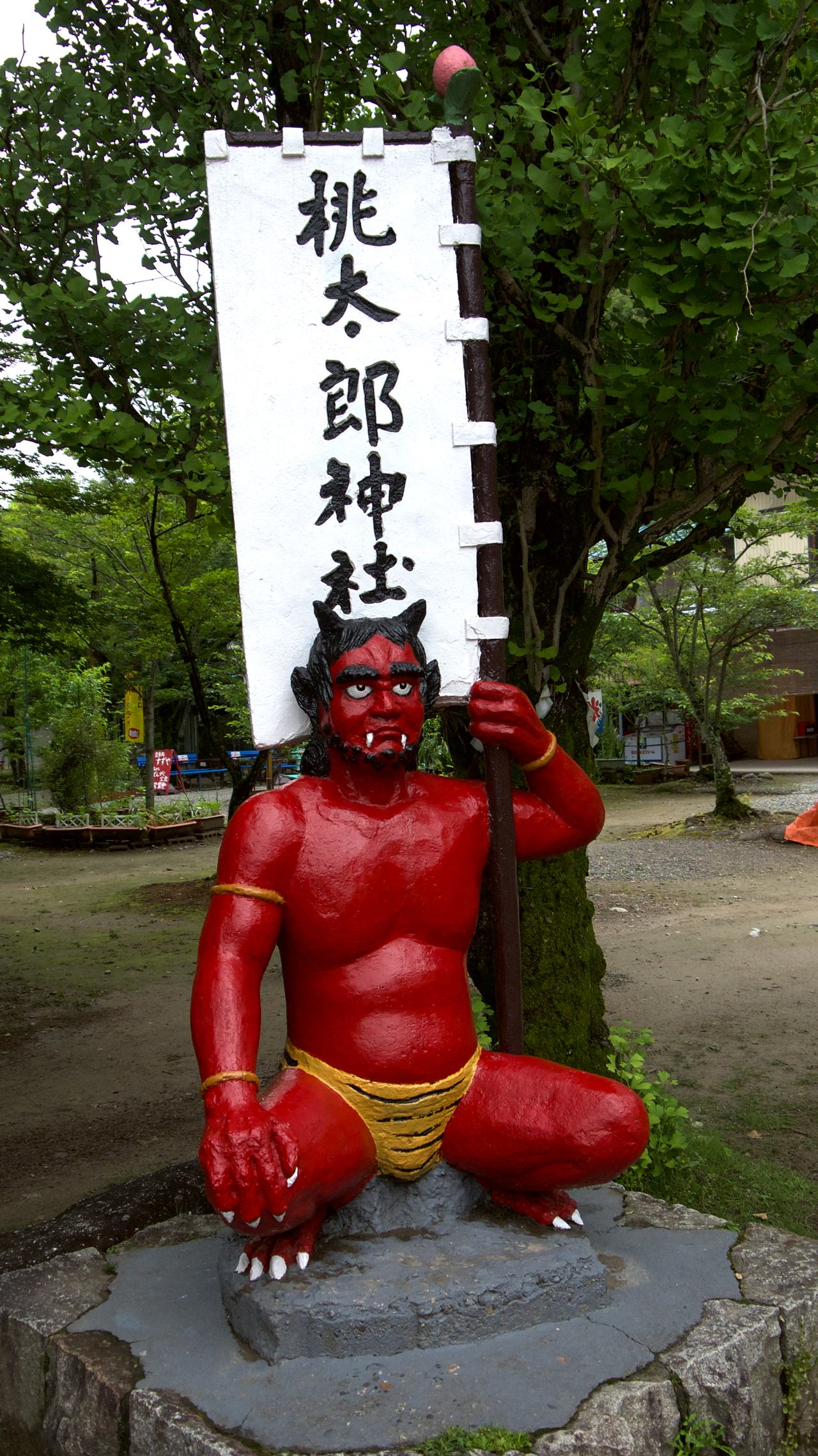
When it comes to Japanese fairy tales, Momotarō is definitely tops. If Japanese folk heroes had a Justice League, he would be Superman.
On the left of the entrance was an oni holding a flag that read "Momotarō Shrine." Remember from the story, Momotarō conquered the oni and made them all his servants. So I guess this one was forced to sit and hold a sign all day.
If you don't know the story of Momotarō let me fill you in real quick:
An ojīsan and obāsan find a giant peach. A baby boy jumps out of that peach. The baby boy is named Momotarō or "Peach Boy" (momo 桃 means "peach" and tarō 太郎 is a suffix meaning "boy"). He grows up and befriends a dog, a monkey, and a pheasant. They all go on a journey to conquer an island full of Japanese ogres.
Momotarō and the animals beat the crap out of the ogres, turn them into servants, and steal all their treasure. The villagers, of course, are overjoyed to have lots of treasure and demon servants. Momotarō marries the village elder's daughter and everyone lives happily ever after.
When it comes to Japanese fairy tales, Momotarō is definitely tops. If Japanese folk heroes had a Justice League, he would be Superman.
Hopefully that will help you understand just how awesome these statues are.
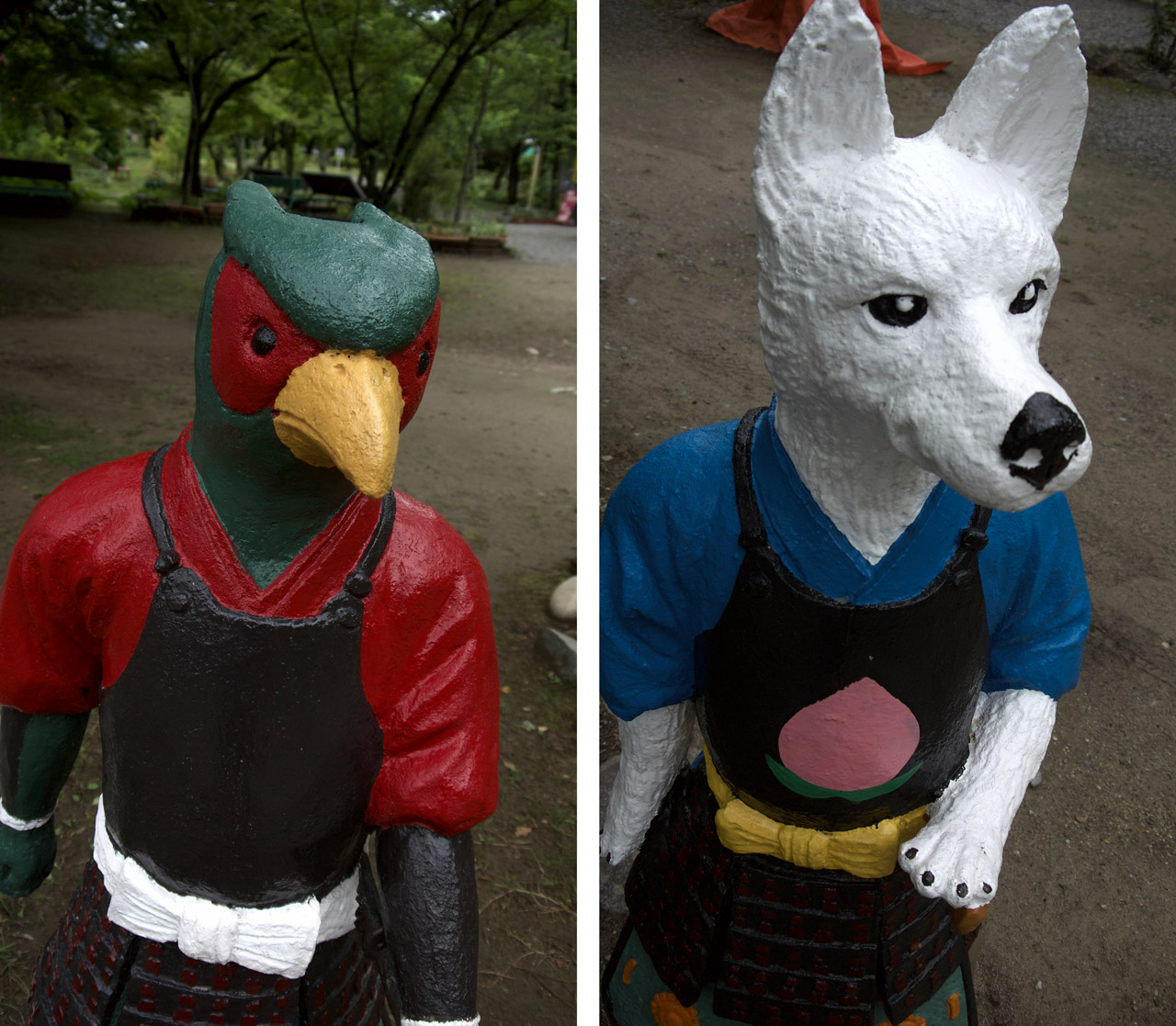
Like the pheasant and the dog, who were waiting past the gate to greet me. They both look very serious. Relax, guys. You already conquered the oni.
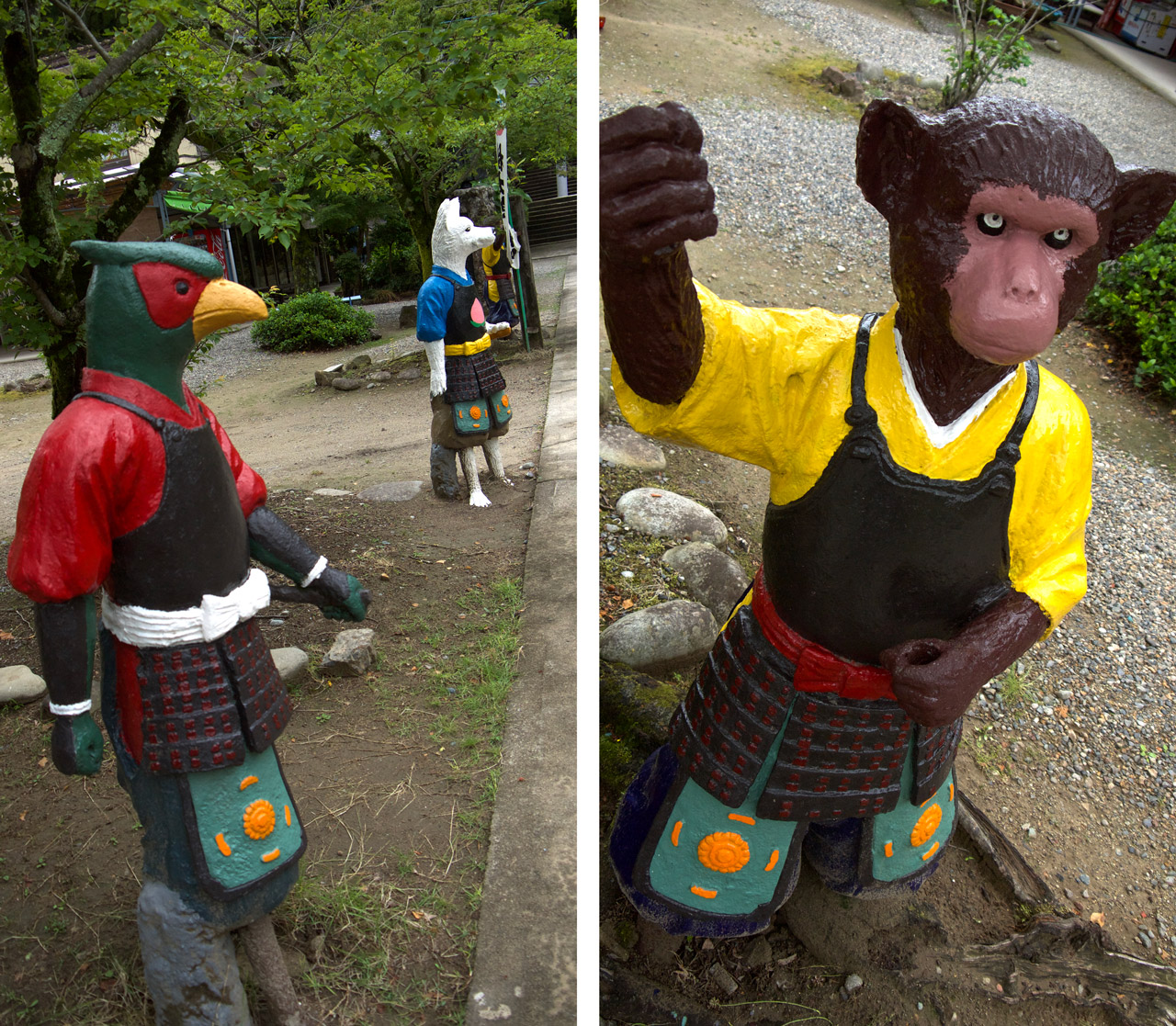
Next to the pheasant and dog was another monkey, but this one looked more sinister than the first one holding that golden ball. Better not look this monkey in the eyes or he might take it as a sign of aggression.
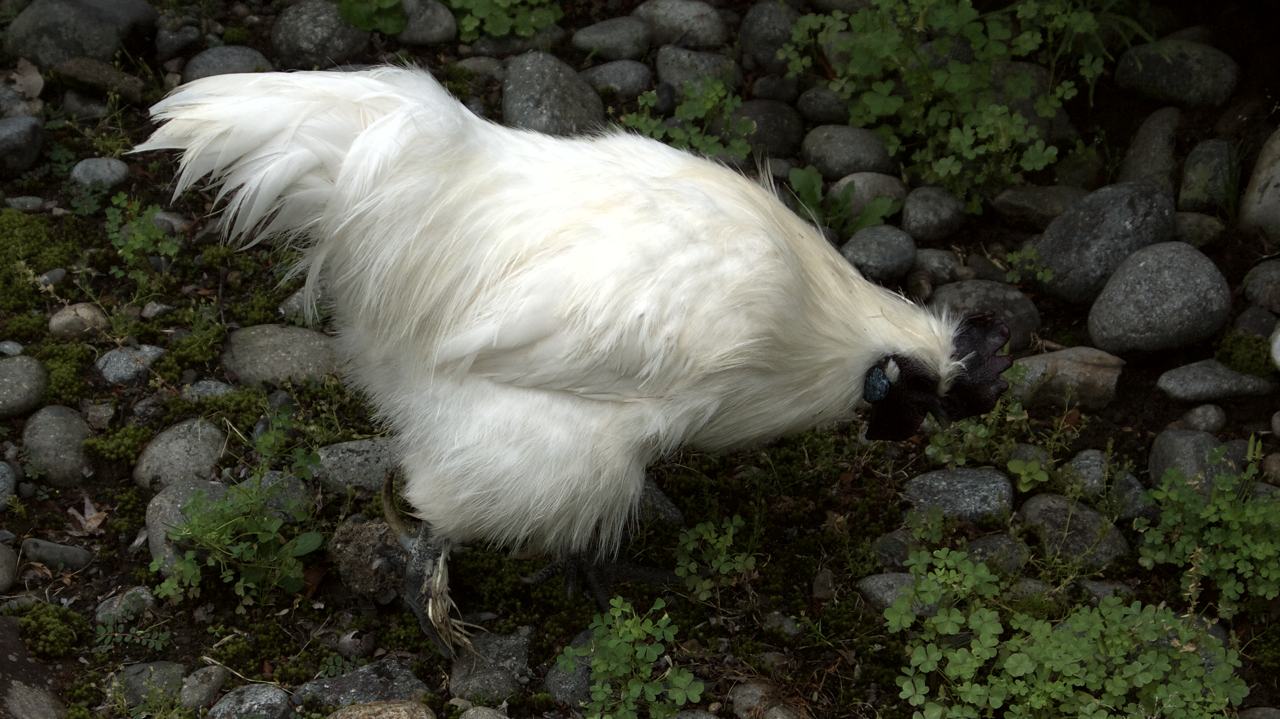
As I walked further into the shrine, I ran into an ukokkei 烏骨鶏 (silkie) breed of chicken. Then I ran into another and another!
Later I learned the chickens live nearby and roam the park as they please. They're someone's pets, so don't even think about eating them. I certainly didn't…
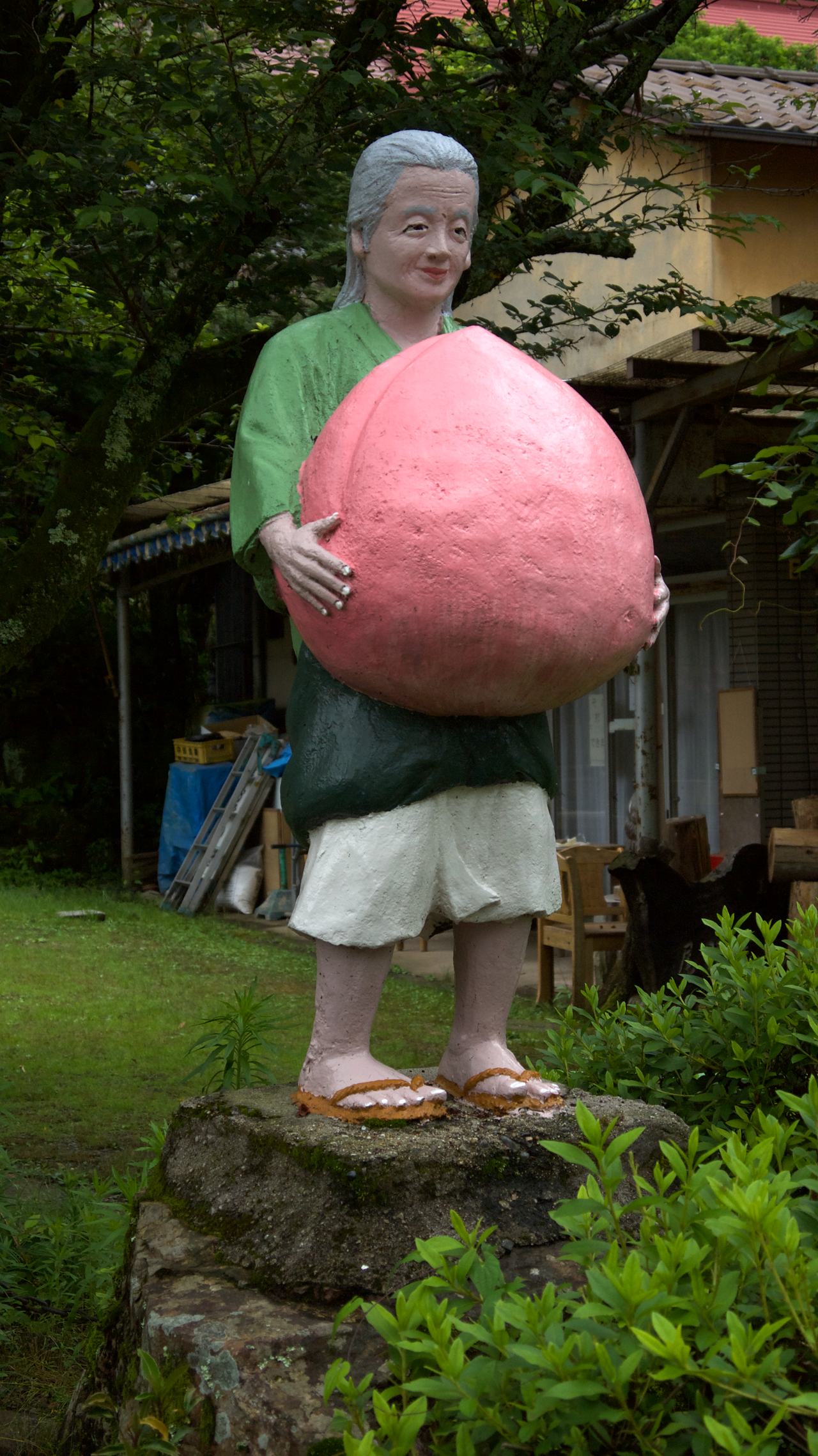
The rock has two footprints in it because (according to legend) the obāsan was a hardcore laundry fanatic and washed her clothes in the same spot for decades.
Not long after my silkie chicken adventure, I found another Momotarō character: the obāsan.
In some versions of the story, she finds the giant peach while doing laundry in the river. So next to this statue is a rock moved from the nearby Kiso river, where it's said she washed laundry every day.
The rock has two footprints in it because (according to legend) the obāsan was a hardcore laundry fanatic and washed her clothes in the same spot for decades. That's right, she wore down rock just by standing on it.
Was she incredibly heavy? Did she have thermal feet? Either way, she was one strong, old lady if she was able to carry a peach that size. What is that, like eleven pounds?
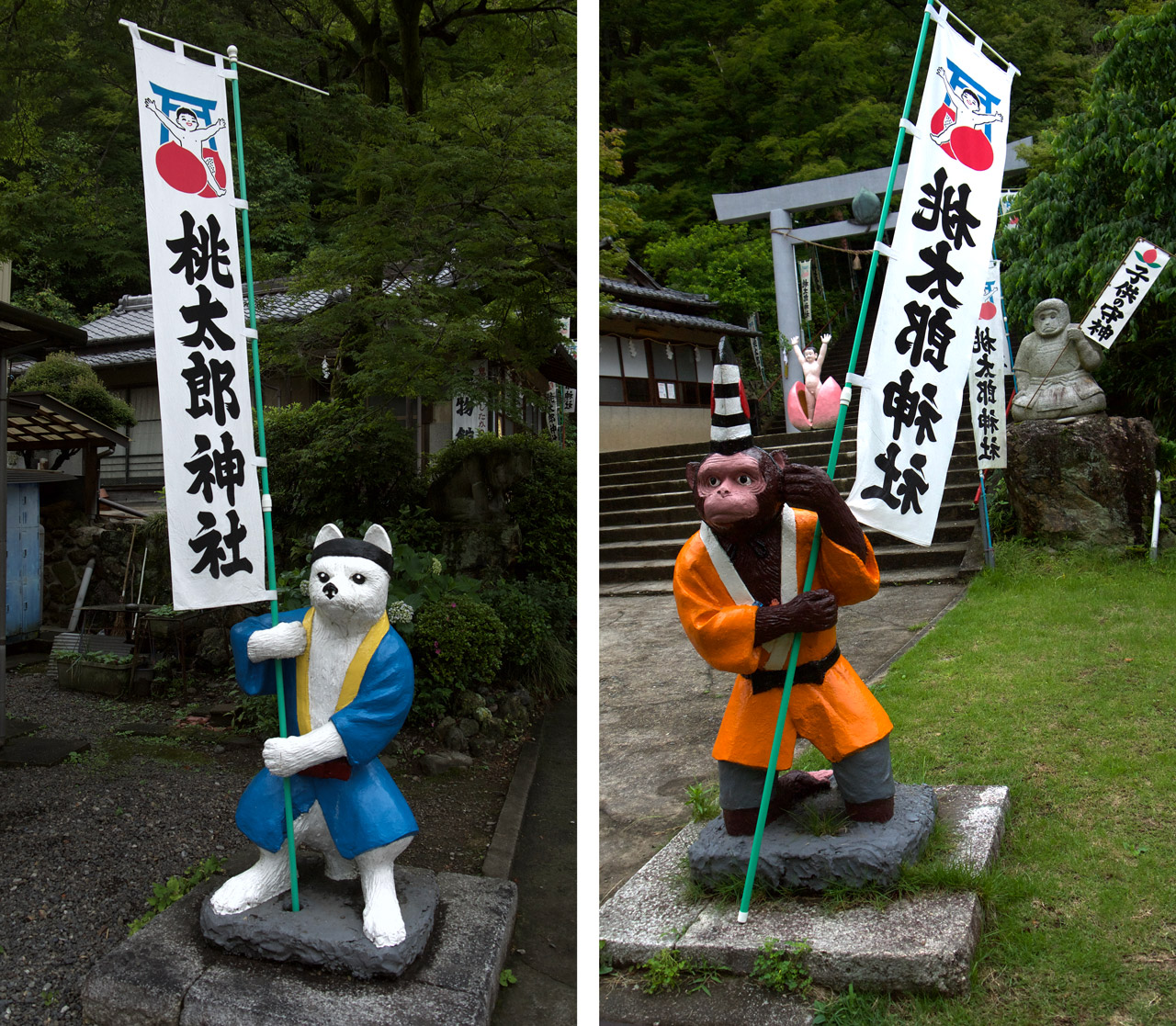
On the way up the steps there was another dog and monkey duo. Why no pheasant this time? (Discrimination?!)
This dog looks kind of like the dad dog from those Softbank commercials.

Then there was yet another monkey. But this one was different. His sign says he's the guardian deity of children. I think. I'm not really sure how the fictional universe of these statues works.
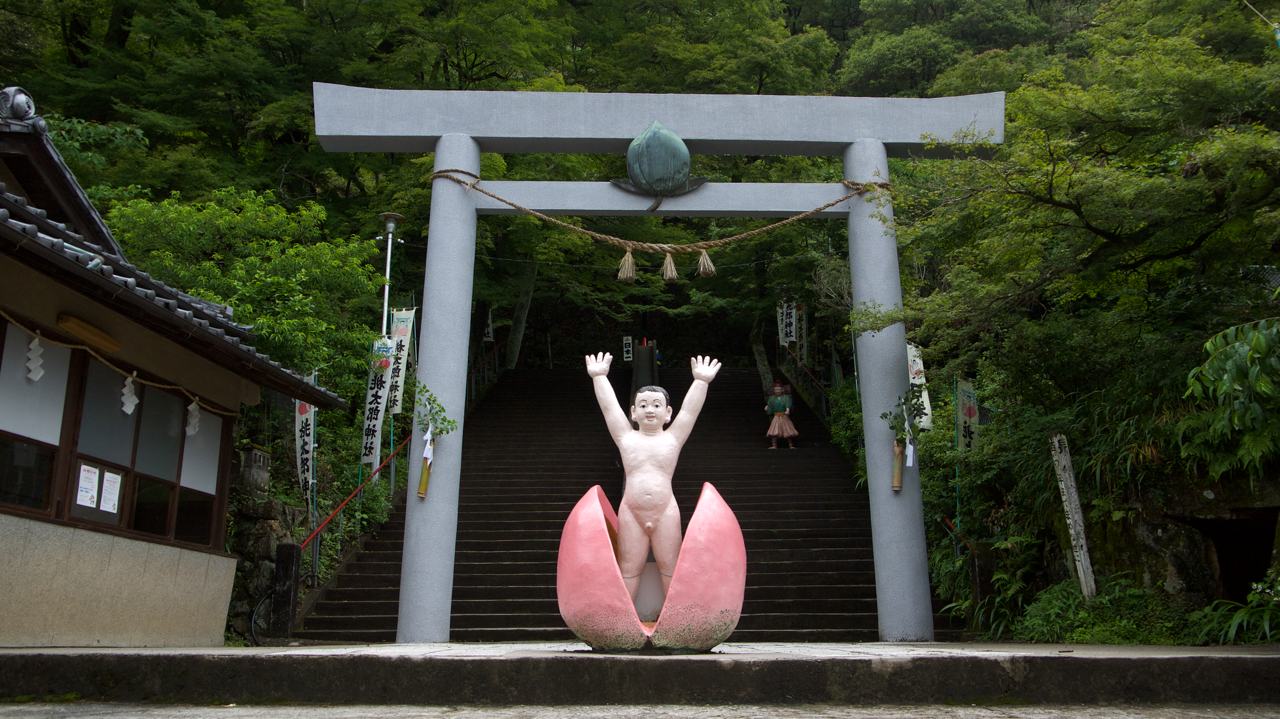
Finally, at the top of the stairs, there he was, the Peach Boy himself, Momotarō! Ta-da!
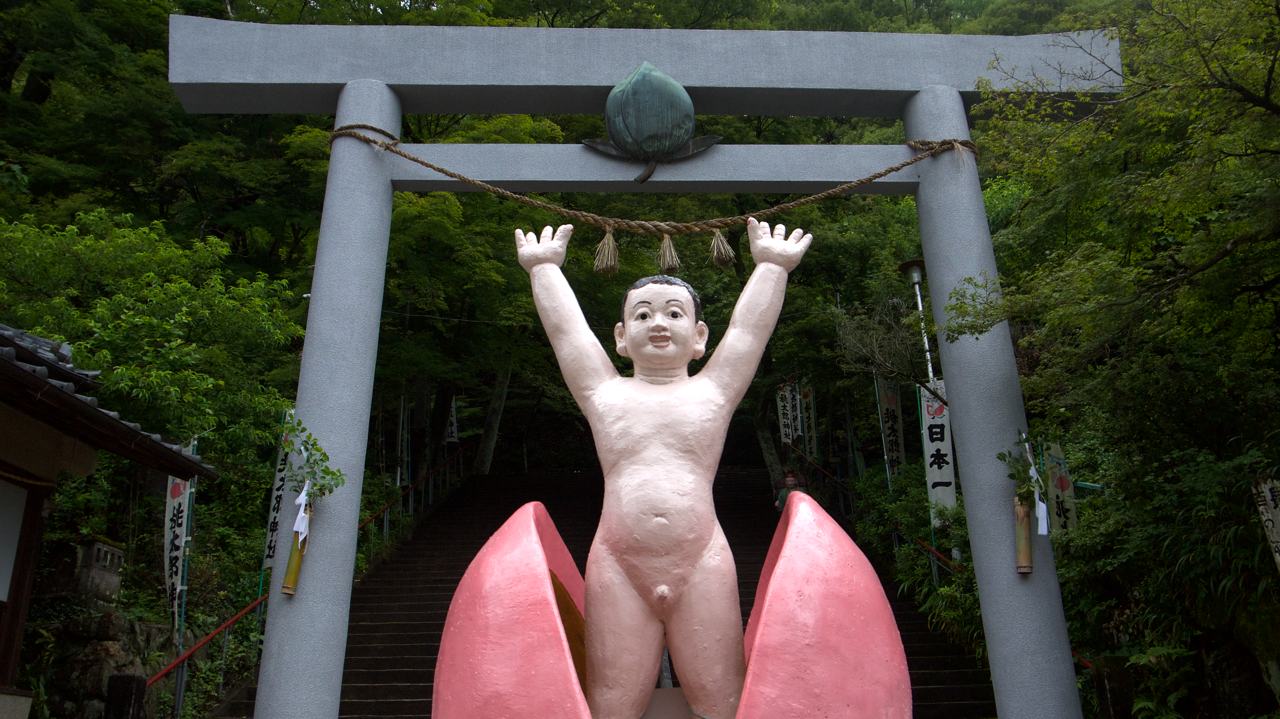
Momotarō is quite the healthy baby. As a newborn, he's already got the body of a six-year-old. Maybe that's why he was able to dispatch those oni as a preteen. With this head start, he probably had a Chris Evans bod at ten.
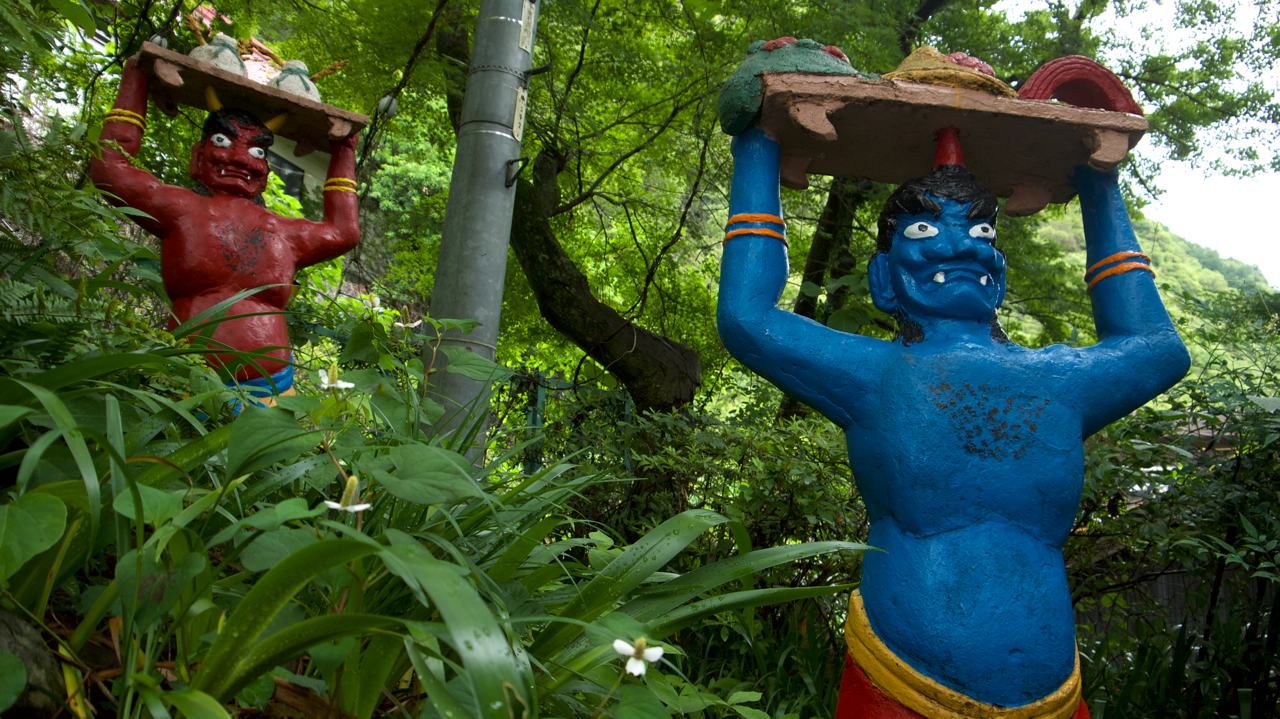
Continuing up the stairs past the nude Peach Boy, I found two oni, one red and one blue, carrying down trays of food. These were some of the captured servants. Poor guys. All they wanted in life was to murder peasants and plunder riches.
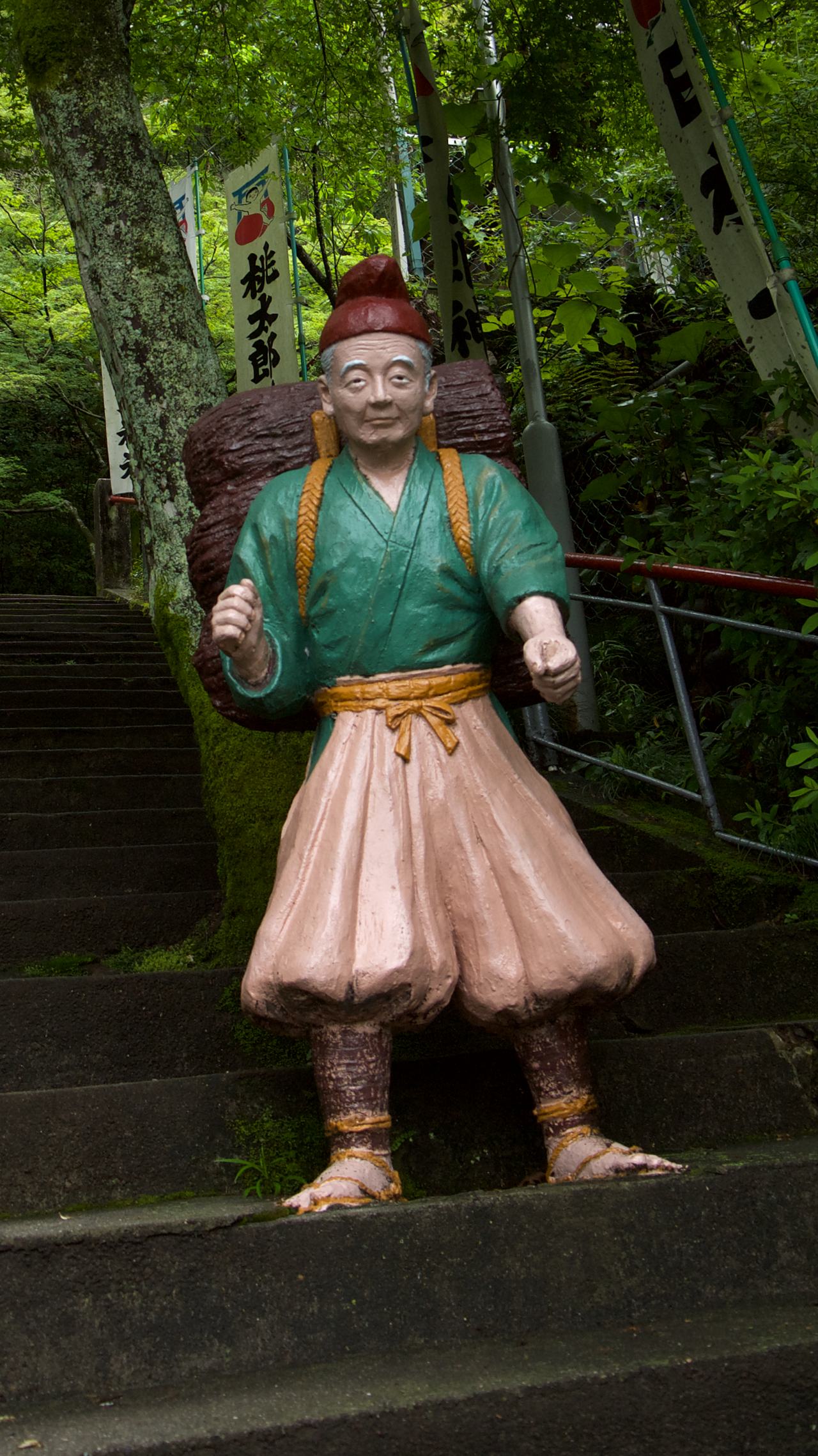
Up the stairs a little more, I found the ojīsan, carrying some logs on his back. Just like a lot of old people in Japan, he's working way past retirement.
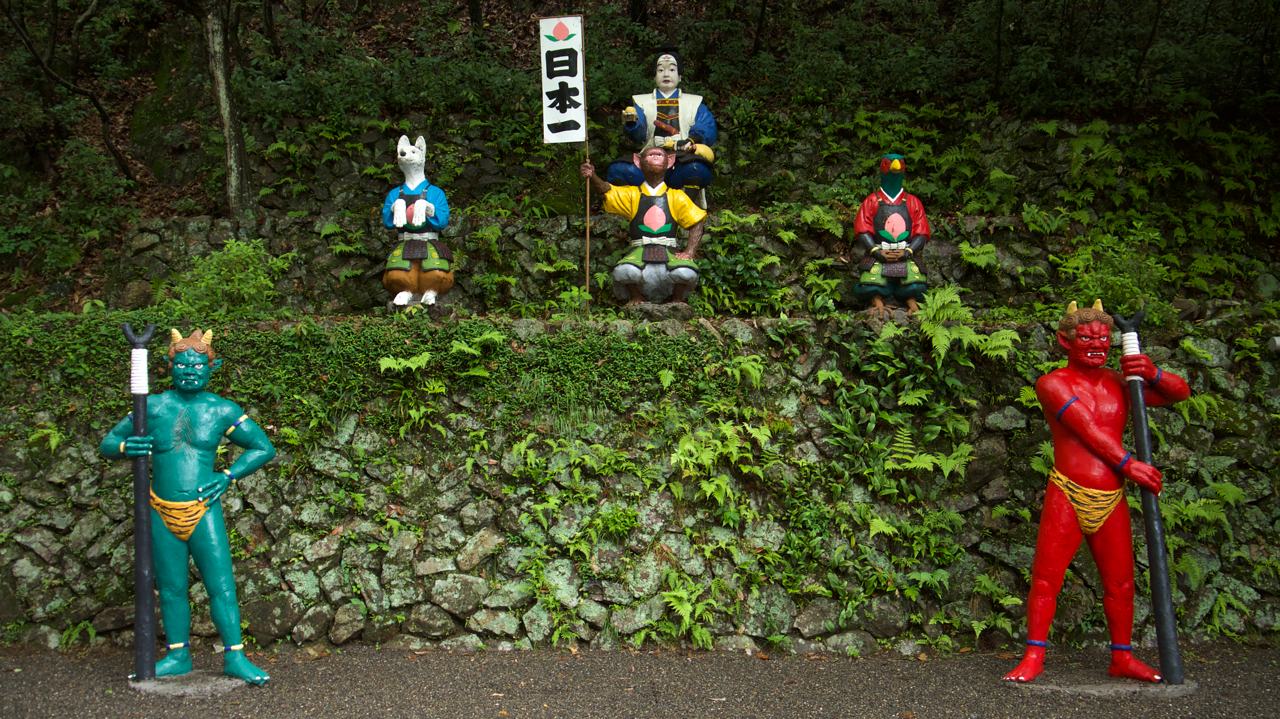

Finally! I came to the top of the stairs and found Momotarō and his animal friends sitting triumphantly above two oni.
The naked Momotarō was like the baby Kal-El emerging from his space peach and here we get the fully formed Superman (with, I guess, Monkeyman, Pheasantman, and Krypto).
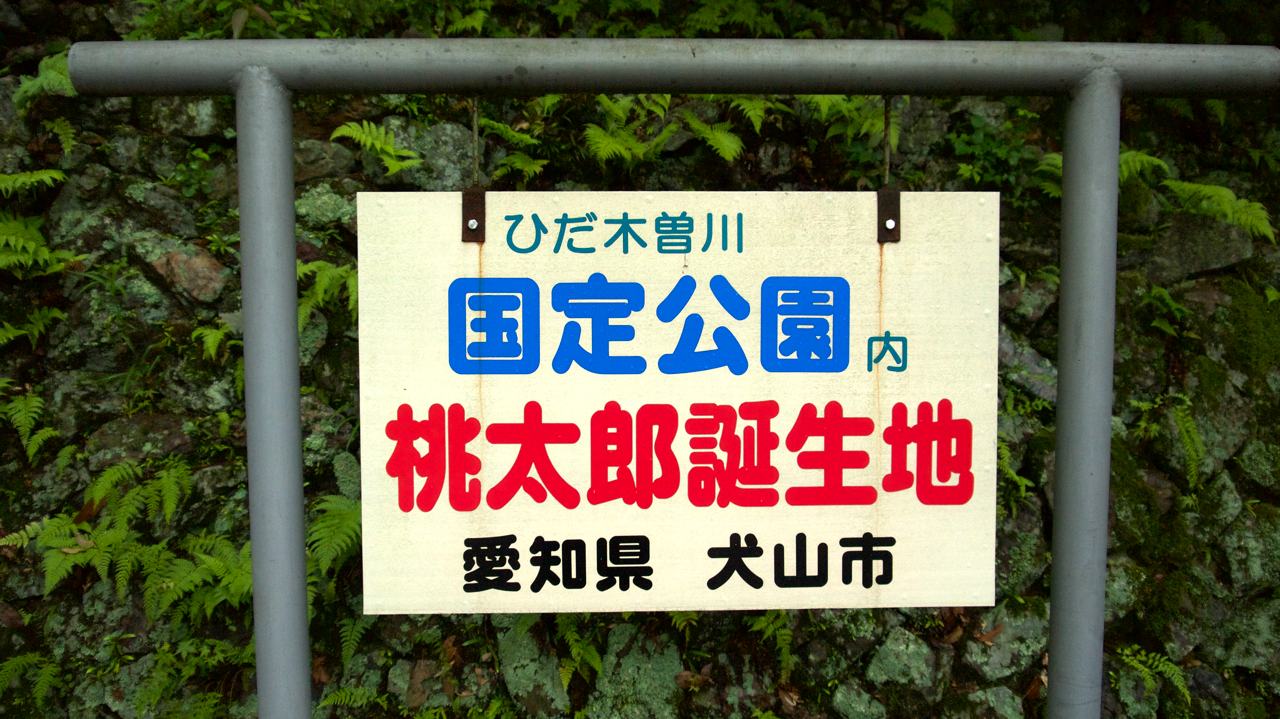
This sign to the right of the red oni states clearly and definitively that this, and no other place, is the real and true birthplace of Momotarō.
Most people think that Momotarō's birthplace is in Okayama (especially people living in Okayama). But this sign changes everything. It really opened my eyes.

To my left was the Momotarō Shrine itself, tucked away behind a peach-shaped torii gate. This peachy torii is probably the only one of its kind in the world (unless Okayama decided to steal it).
More dog, monkey, and pheasant statues were standing guard here, and there was a sign on the gate that read:
桃形鳥居をくぐれば、悪は 去る、病は 居ぬ、災い 来じ.
In Japanese, さる is monkey, いぬ is dog, and きじ is pheasant. So the sentence above is a Japanese pun using the names of Momotarō characters. Get it?
Translated, it means, "If you pass through this gate, your bad luck will go away, your ailments will disappear, and disasters won't come."
So of course, I passed through the gate.
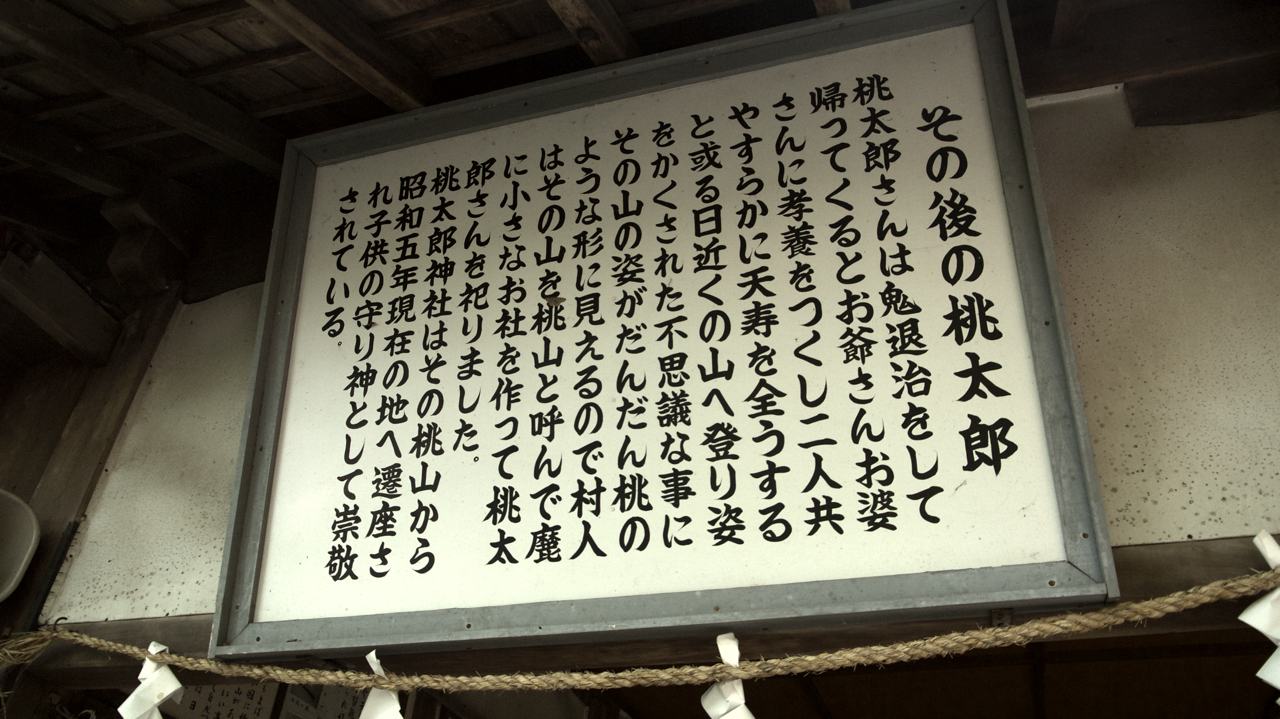
After the ojīsan and obāsan died, Momotarō climbed a nearby mountain and made his home there.
Walking up to the shrine, I found this board explaining the adventures of Momotarō after his oni-conquering expedition and how the shrine came to be:
After the ojīsan and obāsan died, Momotarō climbed a nearby mountain and made his home there. Over time, the mountain started looking like a peach, so people called it momoyama 桃山 and made a small shrine at the base. This Momotarō Shrine was moved from Momoyama to its current location in the fifth year of the Shōwa period (1930).
And there you have it. More irrefutable proof (in sign form) that Aichi Prefecture is the real home of Peach Boy.
Aside from these signs and statues, this shrine is a lot like other Japanese shrines. You can buy paper fortunes, called omikuji, and find out what fate has in store for you.
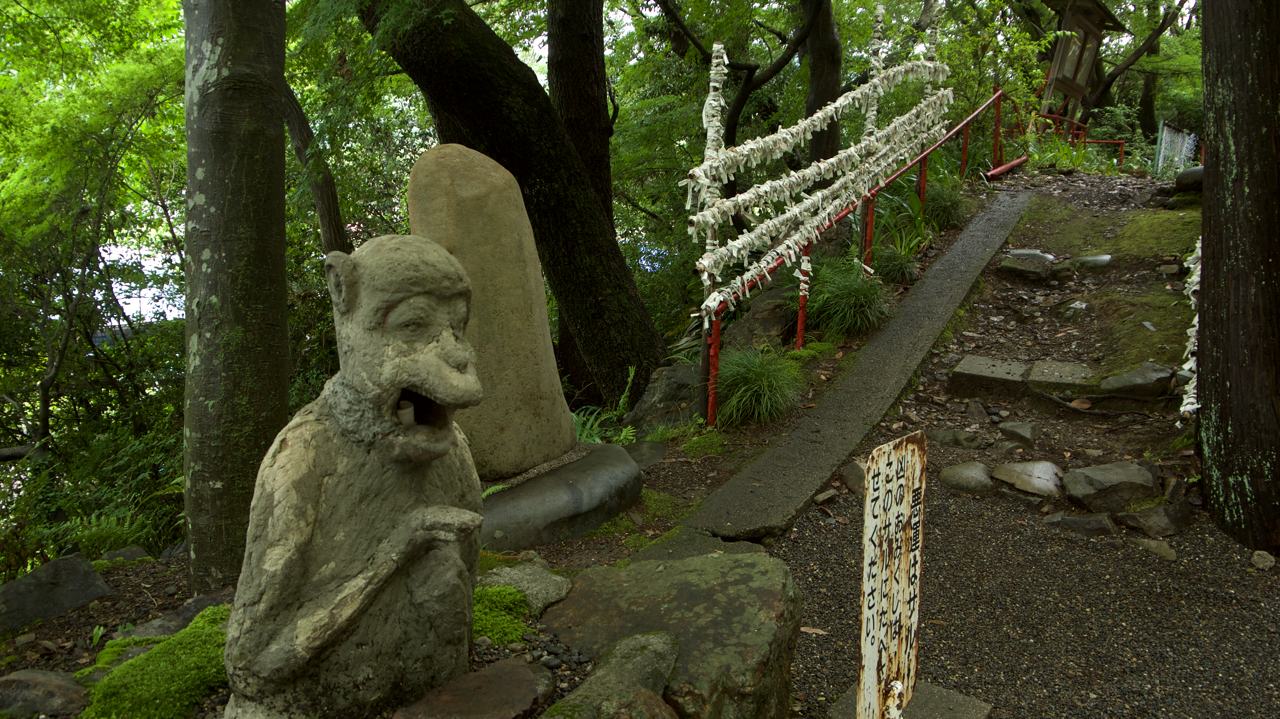
If you get a bad fortune, you can feed it to this monkey statue outside. The sign next to him says he "eats your bad luck," so feed him those nasty fortunes and save yourself. Unfortunately, all that bad luck paper has messed up his face.
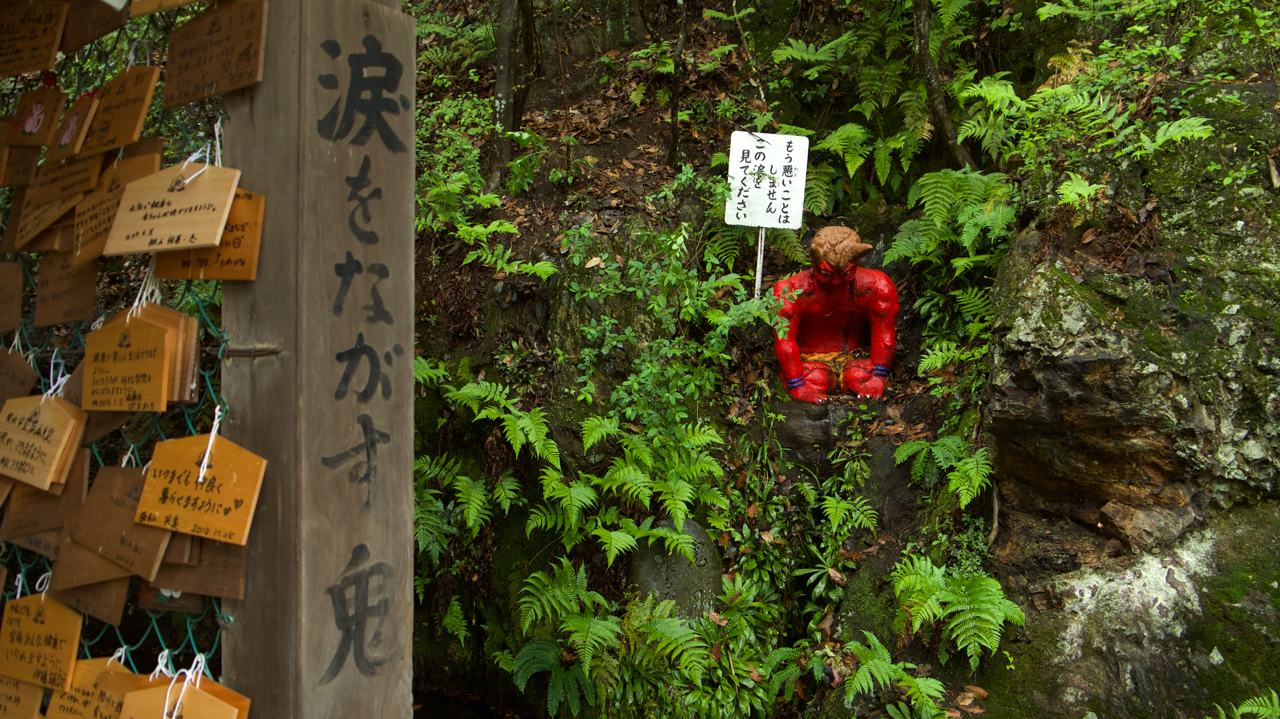
Near the shrine, there's a crying oni hidden in the rock. A sign next to him says, "I won't do bad things again. Please, look at my tears."
I love the weirdness of this one (or I should say, extra weirdness). All the other statues are arranged in such a way that you'll encounter them naturally. This one is tucked away behind the ema 絵馬. It's like he got put in the corner for being especially bad.
What did this crying oni do that was so much worse than all the others? Whatever it is, at least he's remorseful about it.

If you haven't yet had your fill of Momotarō statues (who could ever have enough?), you can check out the museum area called houmotsukan 宝物館. It's only ¥200 (¥100 for kids), so you have no excuse. You spend more than that on UFO catchers.
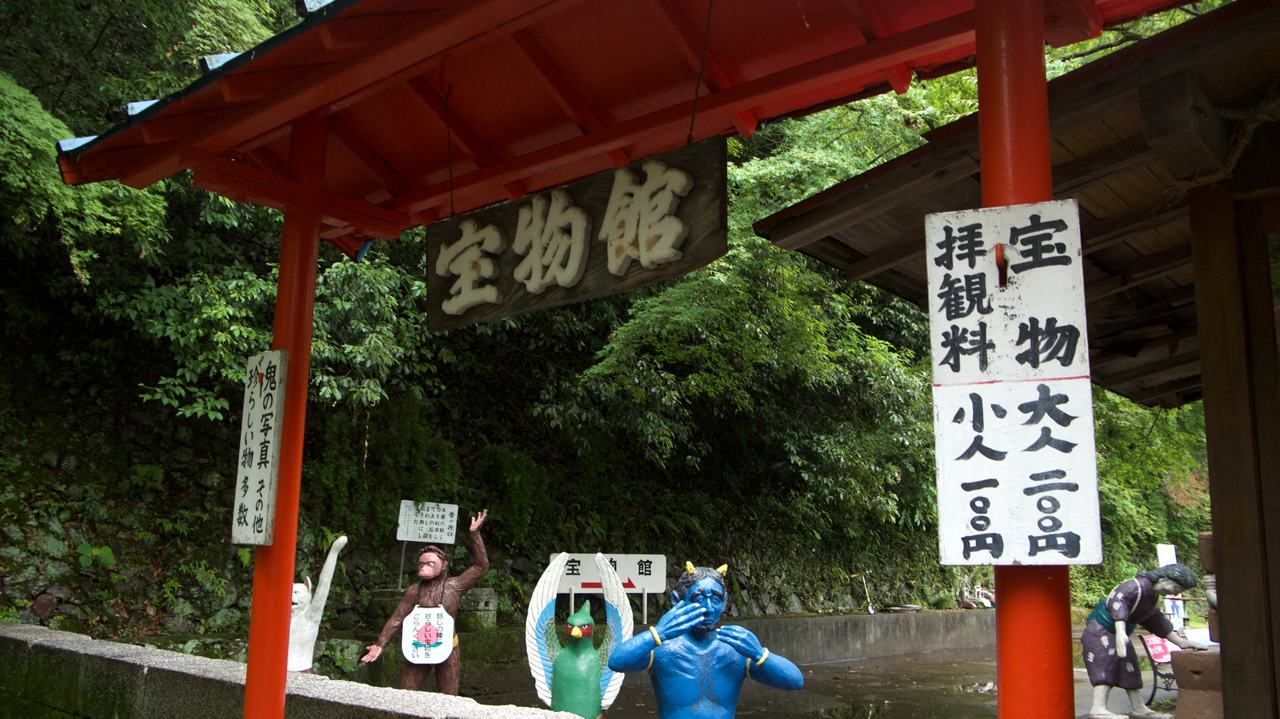
I guess you could just peek over that short wall and see everything, but then you can't get up close and personal with all those Asano Shoun sculptures. Plus you won't get to see all of the Momotarō artifacts in the museum.
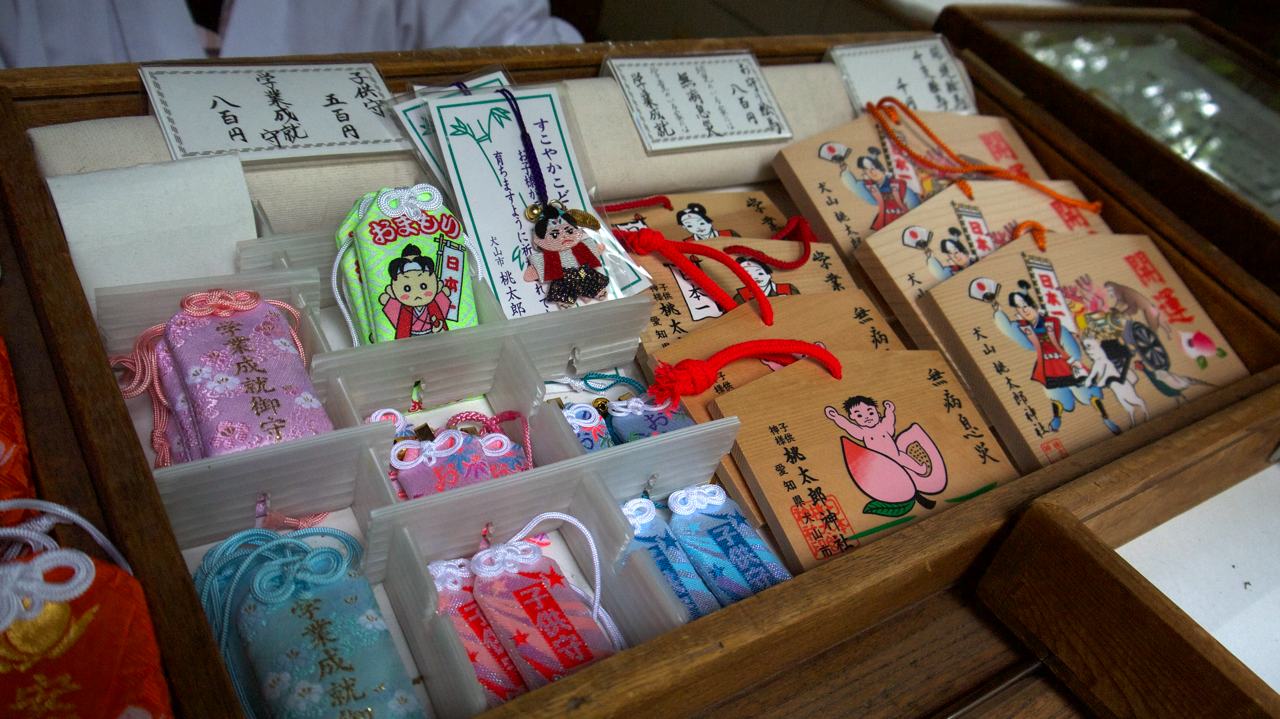
In the museum yard, you can buy Momotarō omamori and ema. I thought about getting one, but I didn't and I've regretted it ever since.

As I entered the yard, I was greeted by this crying blue boy. He must be related to the red oni in the rock. Poor oni-san.
The animals seem pretty happy about something though. Especially the dog!
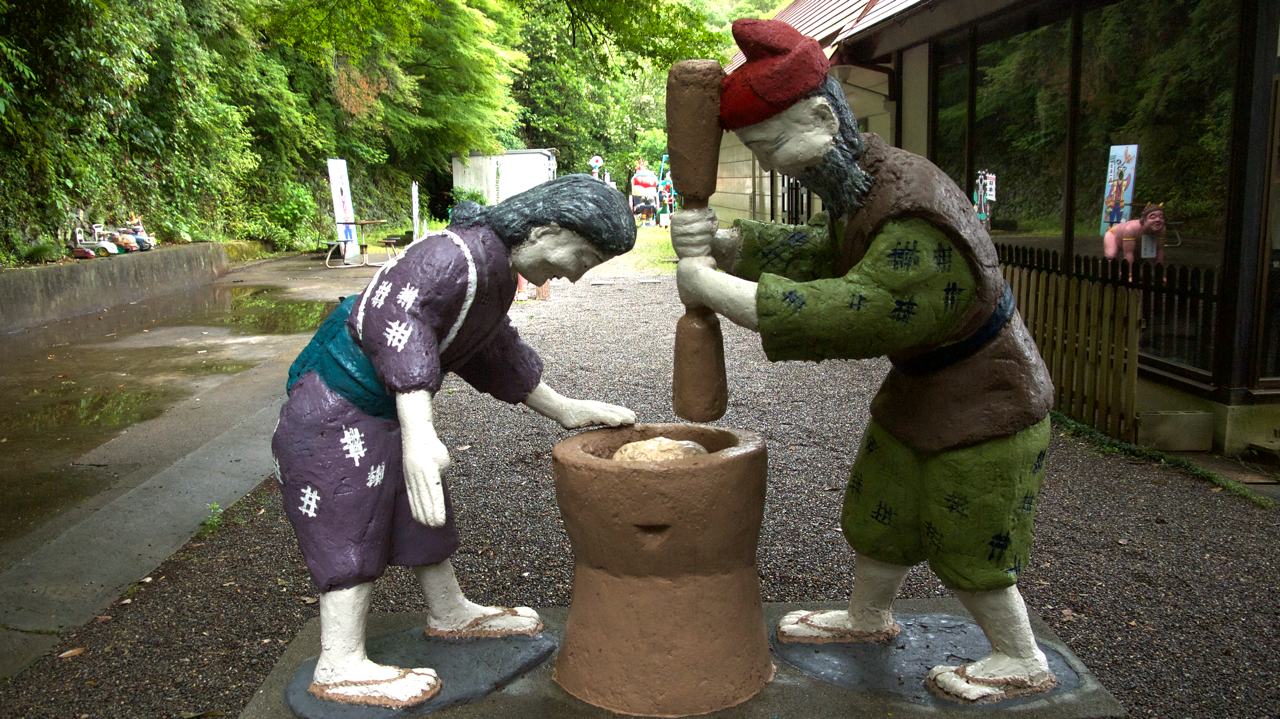
Here's the obāsan and ojīsan making something. Probably kibidango, which is Momotarō's favorite food and a pivotal part of the fairy tale. Or they might be making mochi. There's no telling.
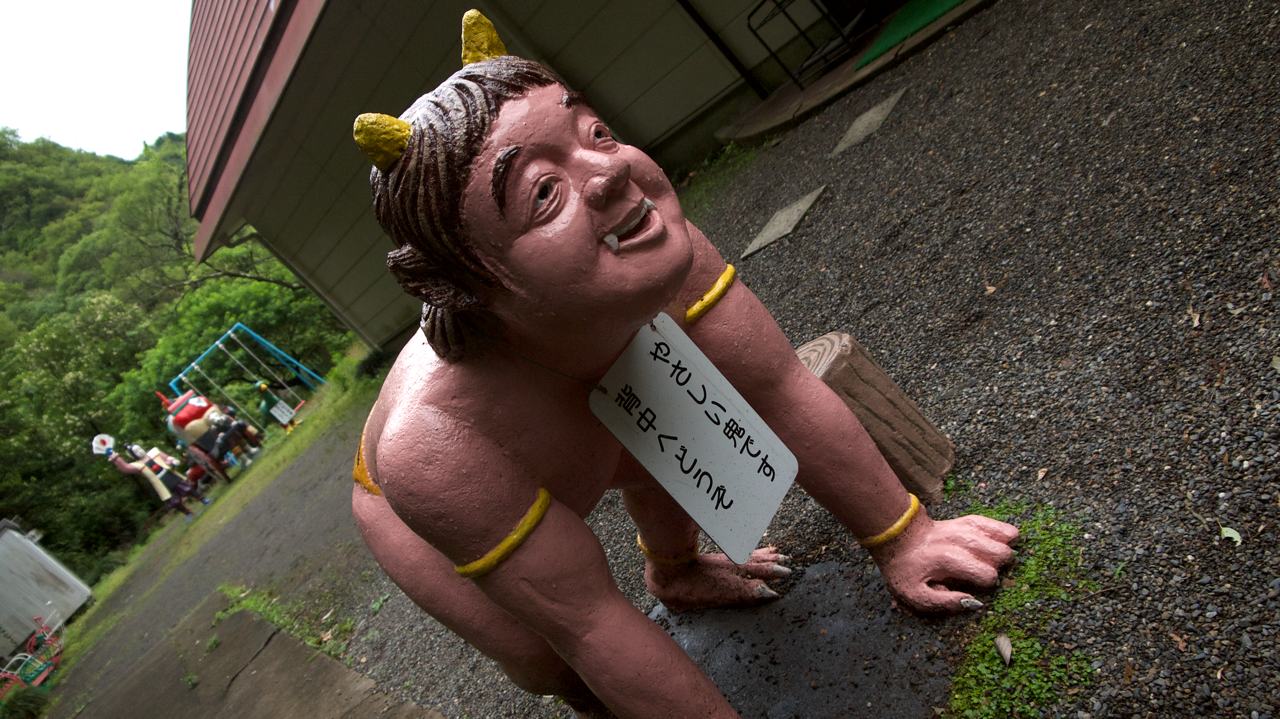
And then I came upon the best, greatest, most wonderful oni in the whole shrine.

This guy! His name is yasashii oni やさしい鬼, which means "kind oni." He's the only ogre with a smile on his face.
The sign around his neck reads, "I'm the kind oni. Please go ahead and ride on my back."
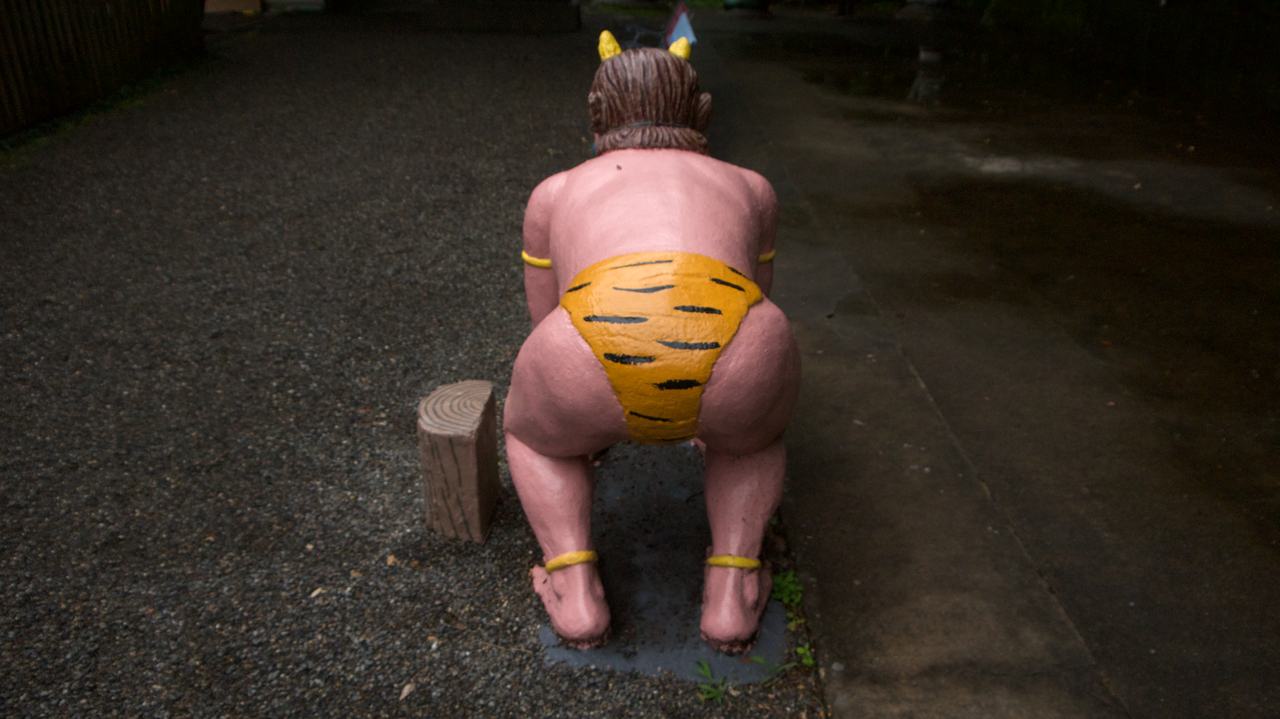
I was going to hop on, but then I saw him from this angle. That oni butt staring at me… I couldn't do it.
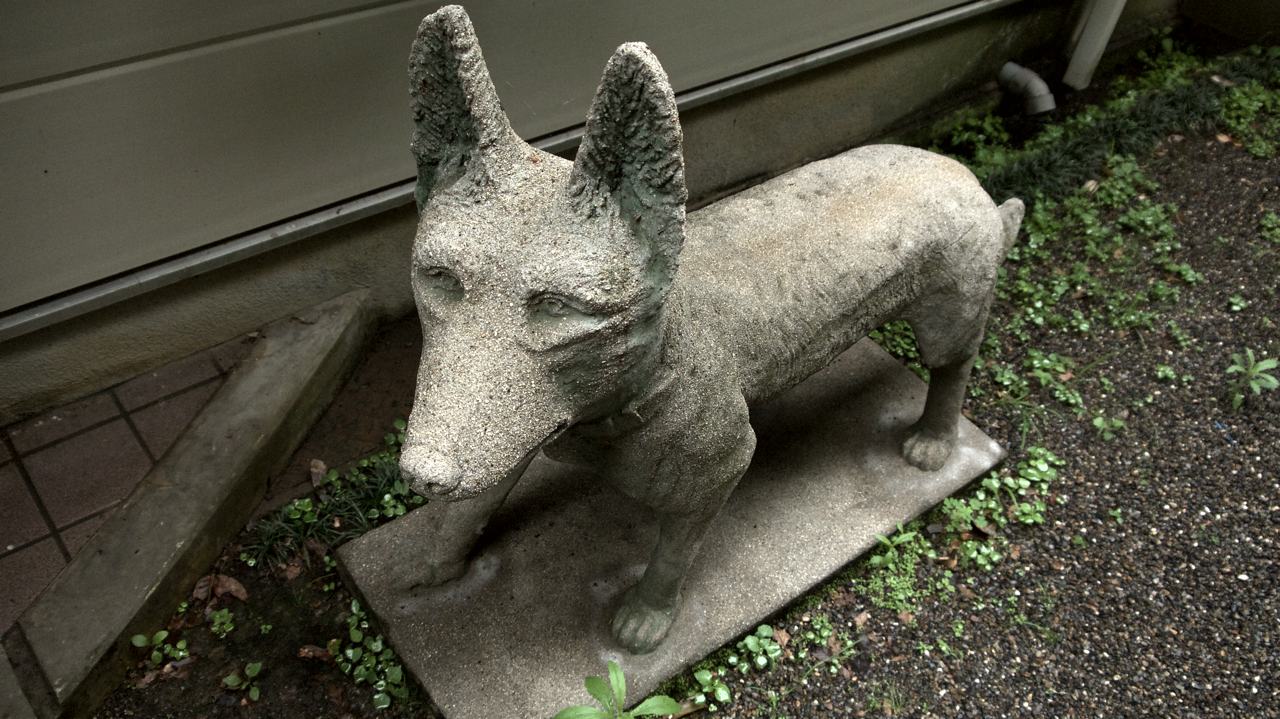
Before I left, I found a few other non-Momotarō-related things that made me smile.
This little cutie was in a corner by the wall. You could consider him the Momotarō dog, but I'm pretty sure he's just a regular dog turned to stone.

There were also some kids toys. I wasn't sure if they were there for visiting children to play with or if they were just abandoned. I think I had the one in the middle when I was three.
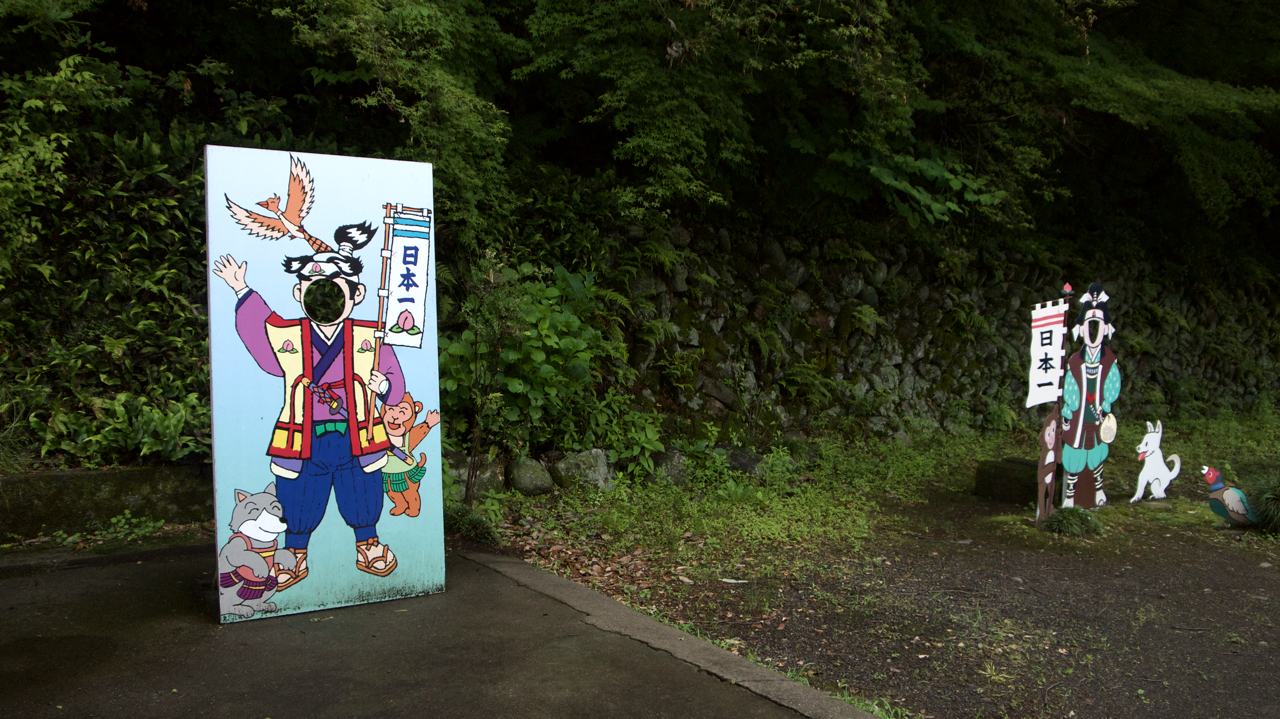
There were face-in-the-hole boards (or whatever you call them) that you can use to pretend that, just for a second, you are as brave as Momotarō.
I wanted to do it but I was all alone and there was no one to take my picture. I'll have to come back with the whole Tofugu team someday.
Just when I thought there couldn't be any more statues… there were more statues.

This scene depicts Momotarō and his crew on their way home with the spoils of their adventure.
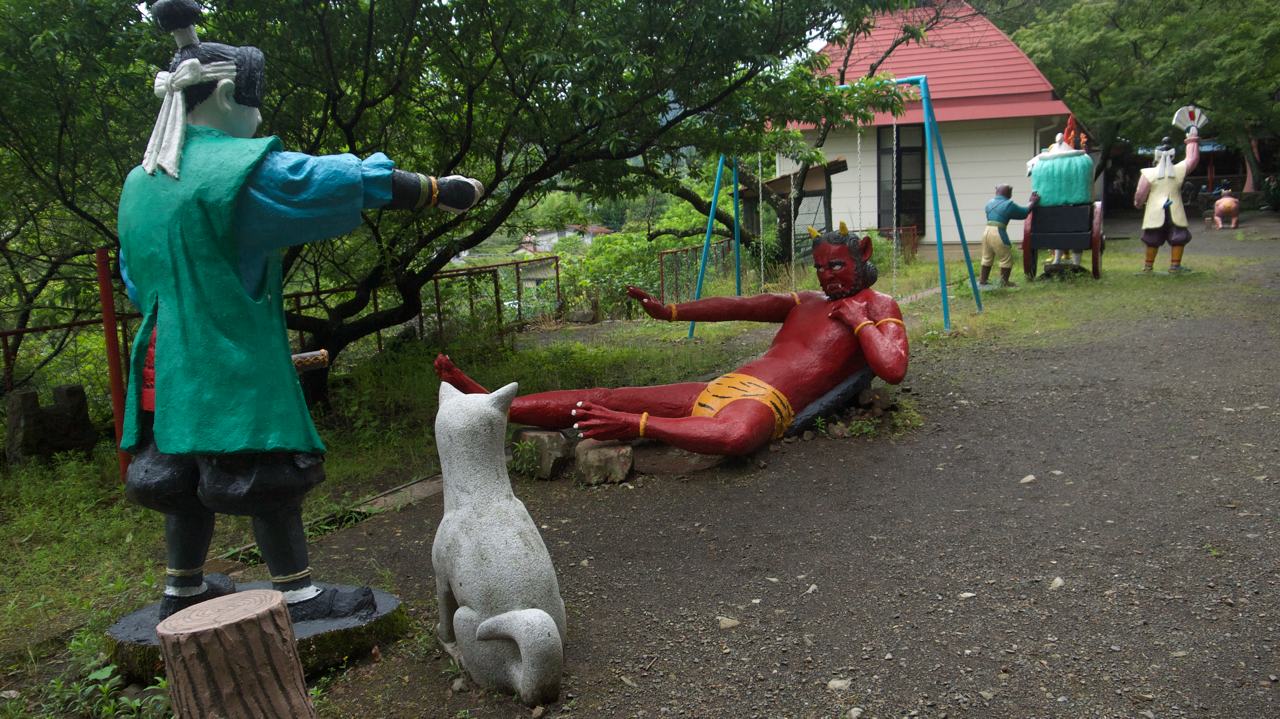
There was also a scene with a conquered oni. So conquered that oni was. What did they ever do to deserve such treatment? (Besides drinking people's blood.)
There was something unnerving about that oni's pose…
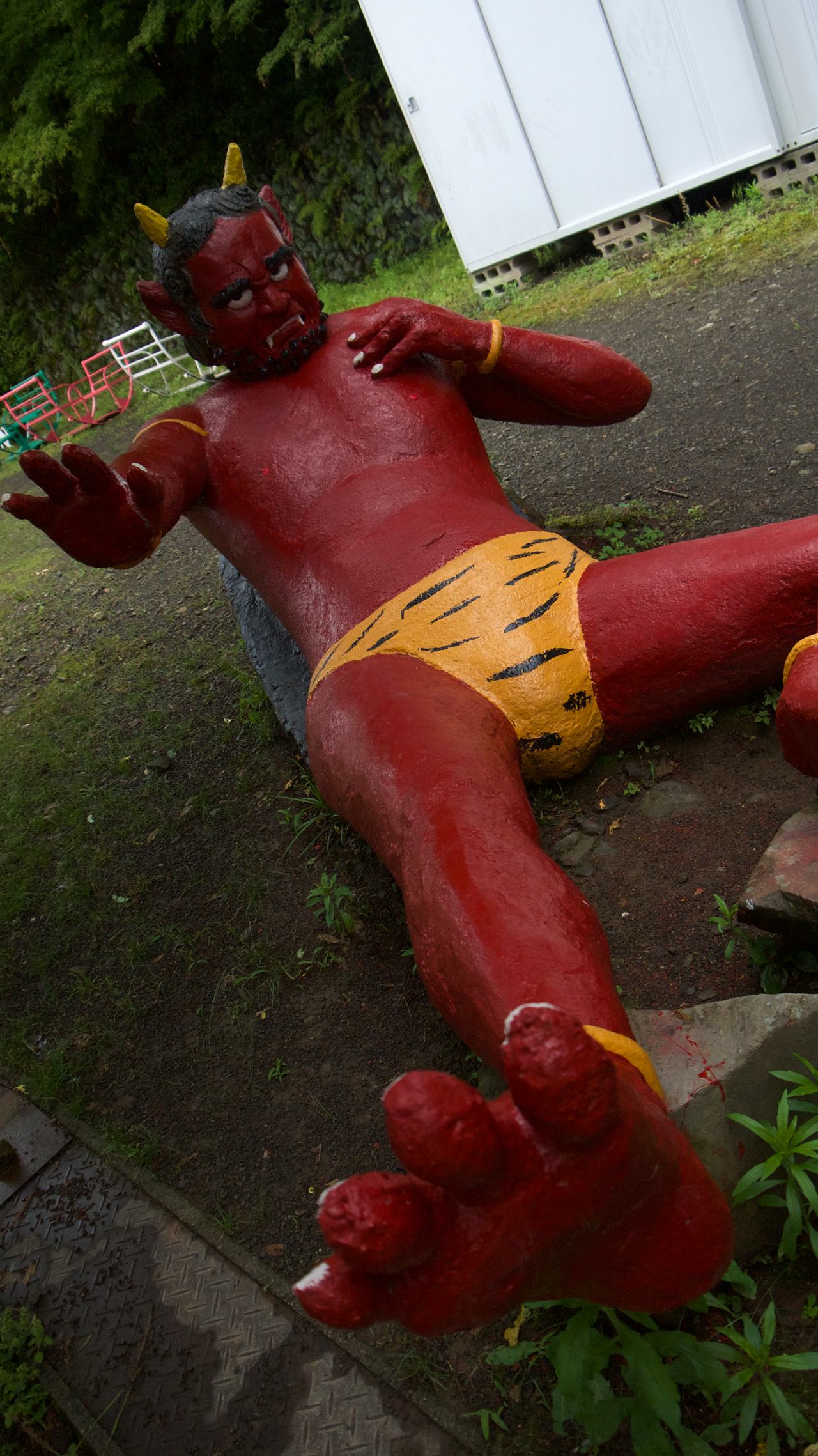
Next up was the Momotarō Museum! This shrine just kept unfolding into more and more peachy delights.
As soon as I entered the museum I was faced, once again, with rock-solid evidence that Momotarō was from Aichi. And of course, it was printed on a sign.
How much more evidence do you need? I already read the other two very authoritative signs!
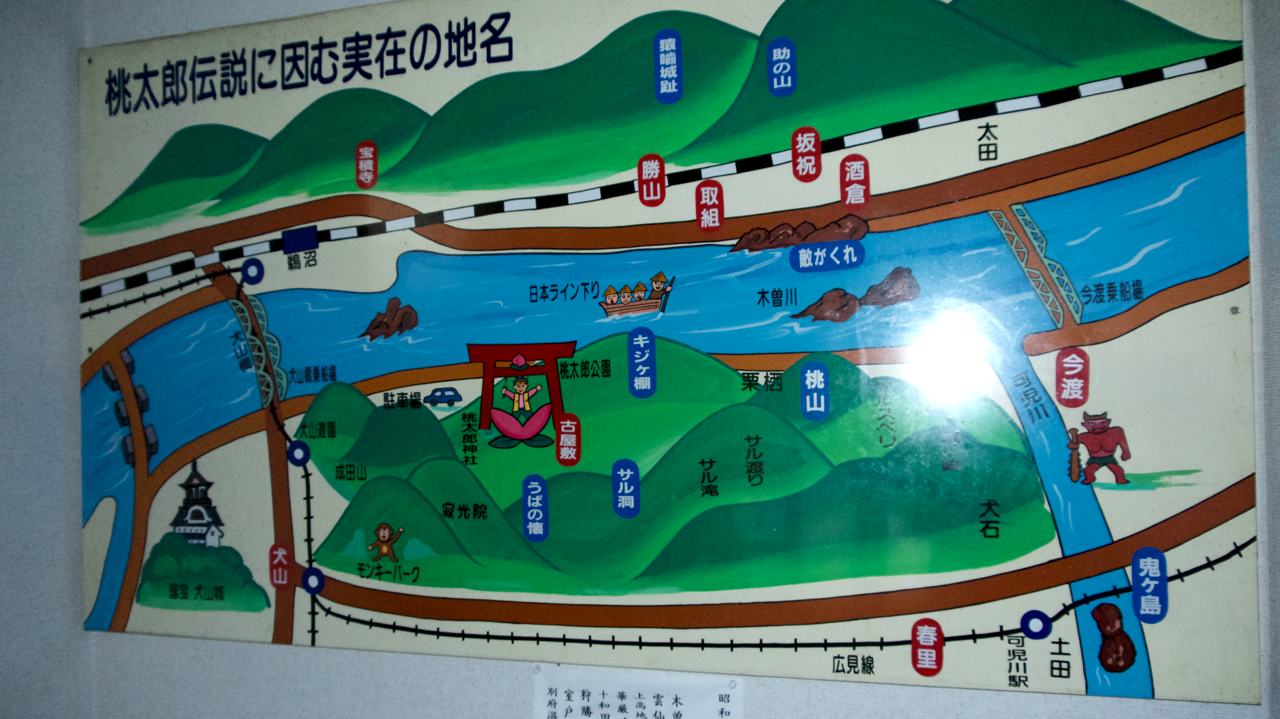
Some people might feel disappointed by this. But other, more sophisticated people can appreciate an official, city-funded museum full of knick knacks.
This picture illustrates Inuyama City's Legend of Momotarō, which basically just names different cities in the Inuyama area and what Momotarō did there.
These are all real places in Inuyama, so this proves Momotarō visited all of them. If you're not convinced now, you never will be.
As I moved further into the museum I saw display cases filled with artifacts from Momotarō's journey.
There was an oni's iron rod (used to bludgeon), an oni penis the dog bit off, and a photo of the peach that Momotarō jumped out of. Sadly, that last artifact only exists in photo form because an arsonist tried to burn down the shrine in 2000.
Besides these artifacts, the museum was… Momotarō knick knacks, figures, and… stuff. Sorry, there's no other way to put it. Some of the "stuff" isn't even Momotarō related; just random figurines of dogs and monkeys and pheasants.
Some people might feel disappointed by this. But other, more sophisticated people can appreciate an official, city-funded museum full of knick knacks.
If you're reading this, you're probably that sophisticated person.
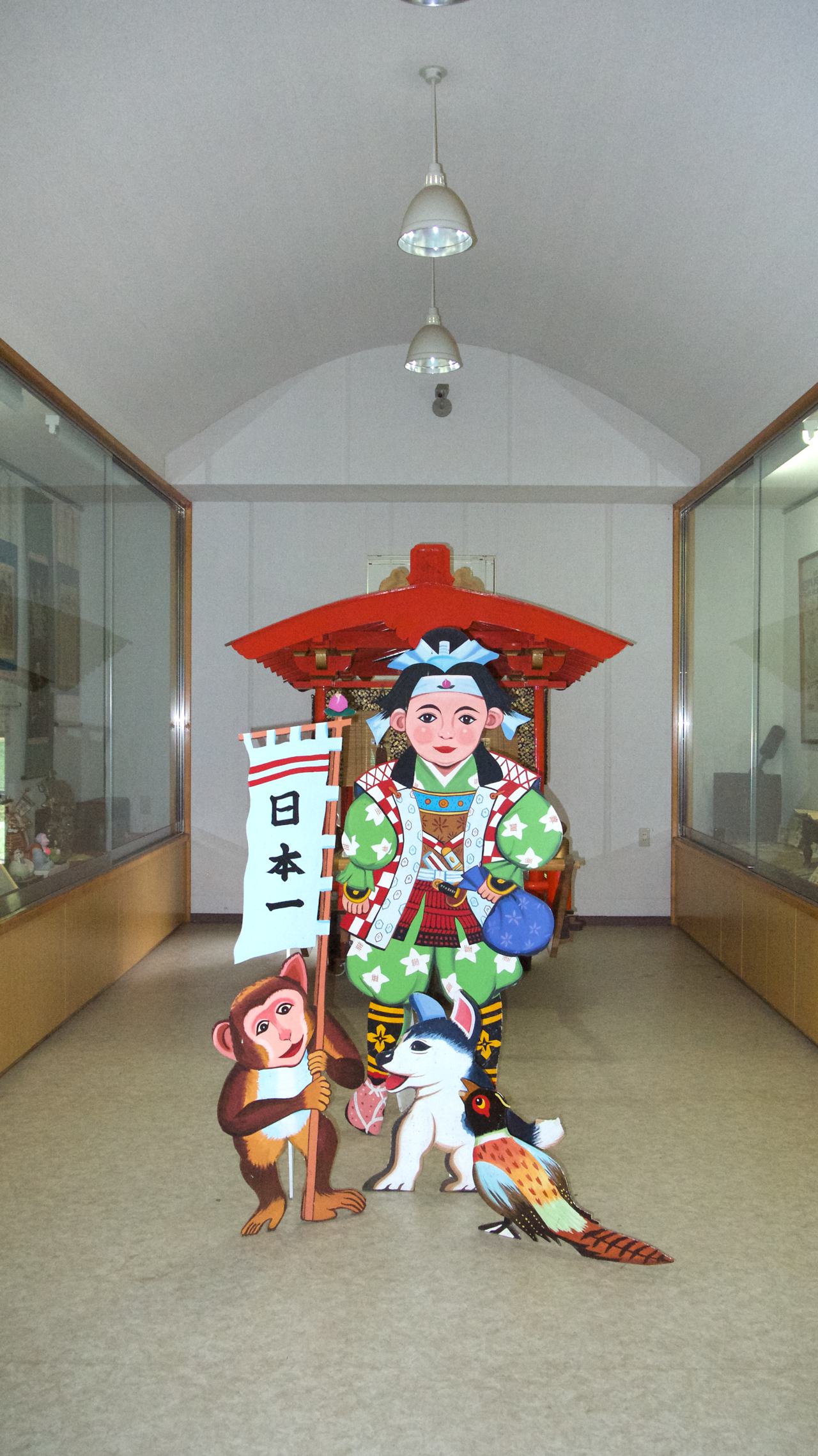
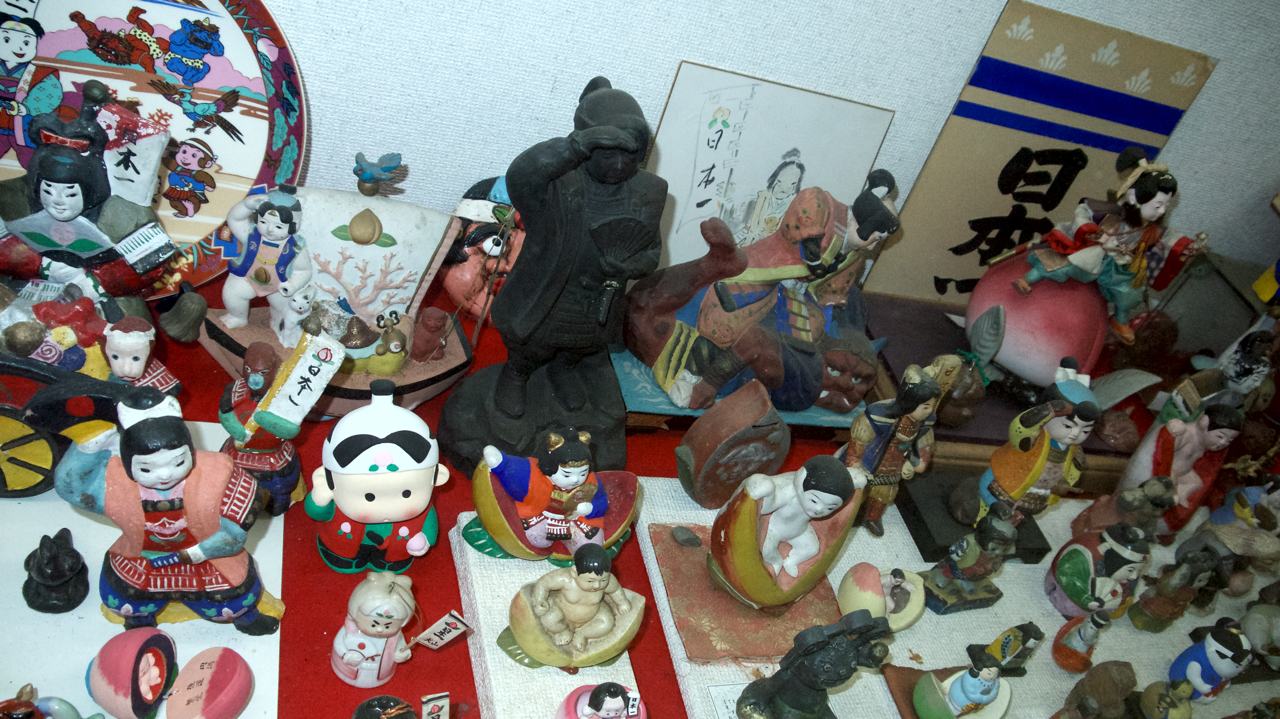
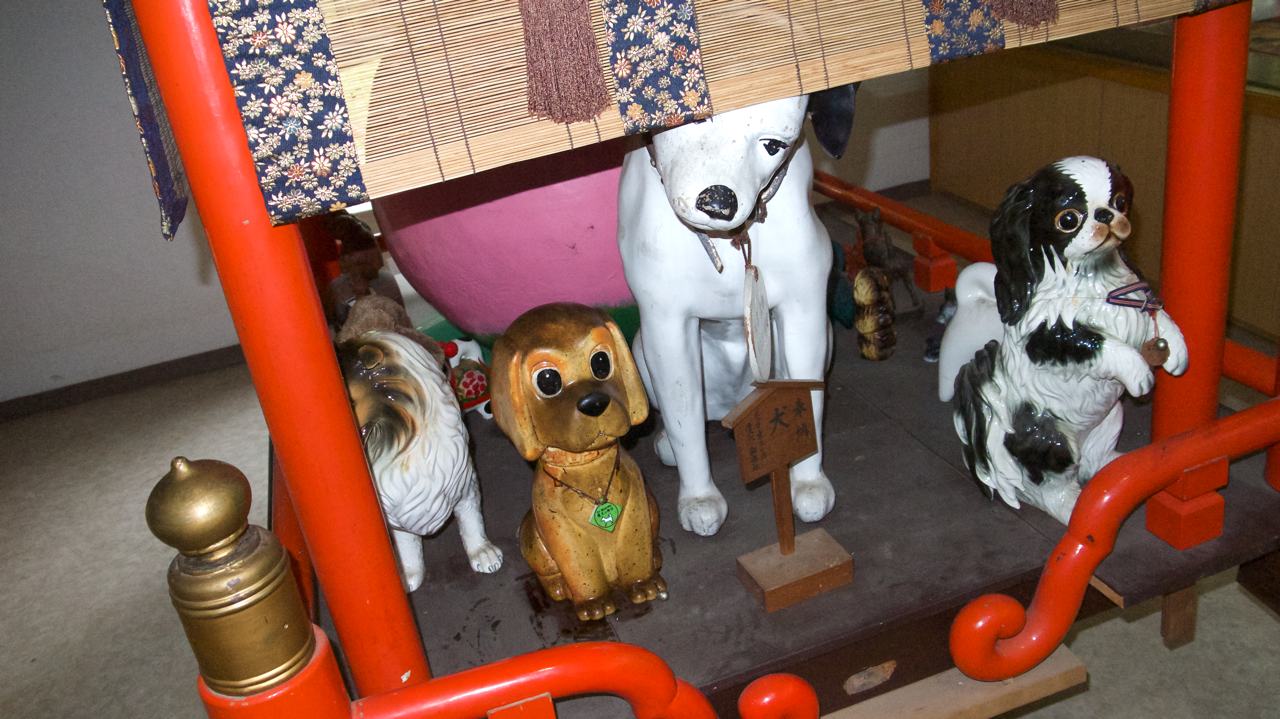
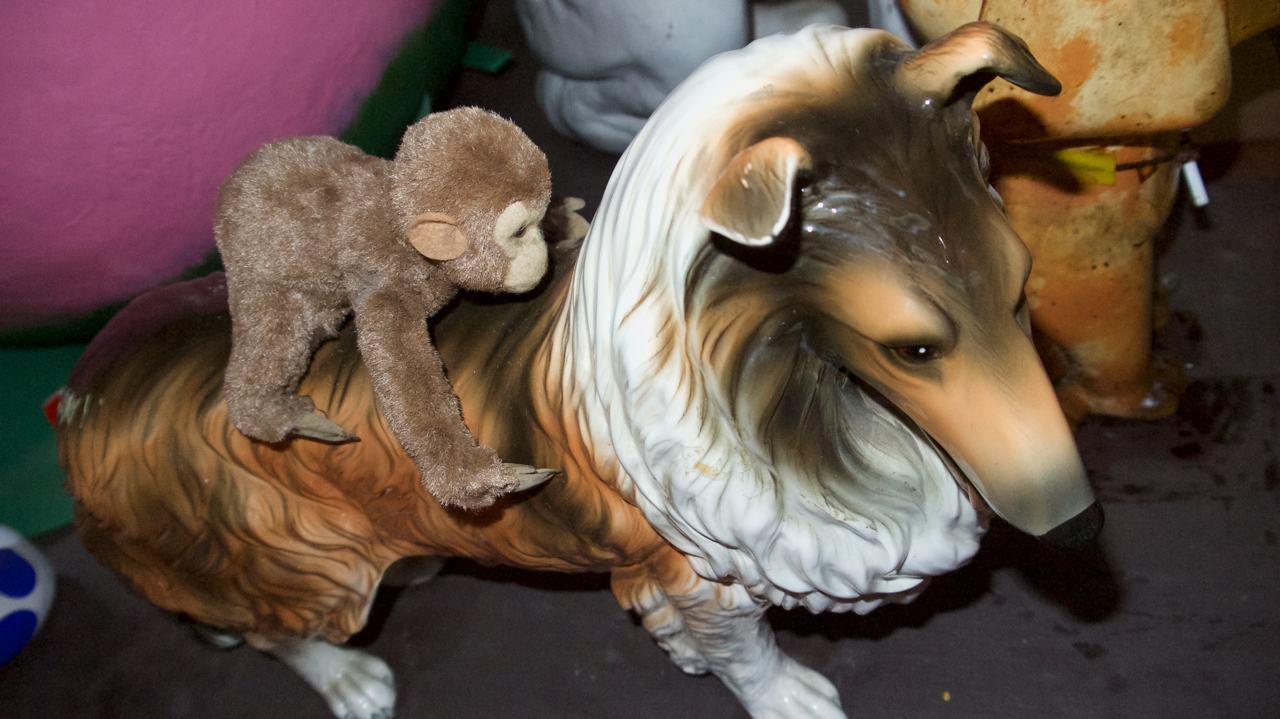

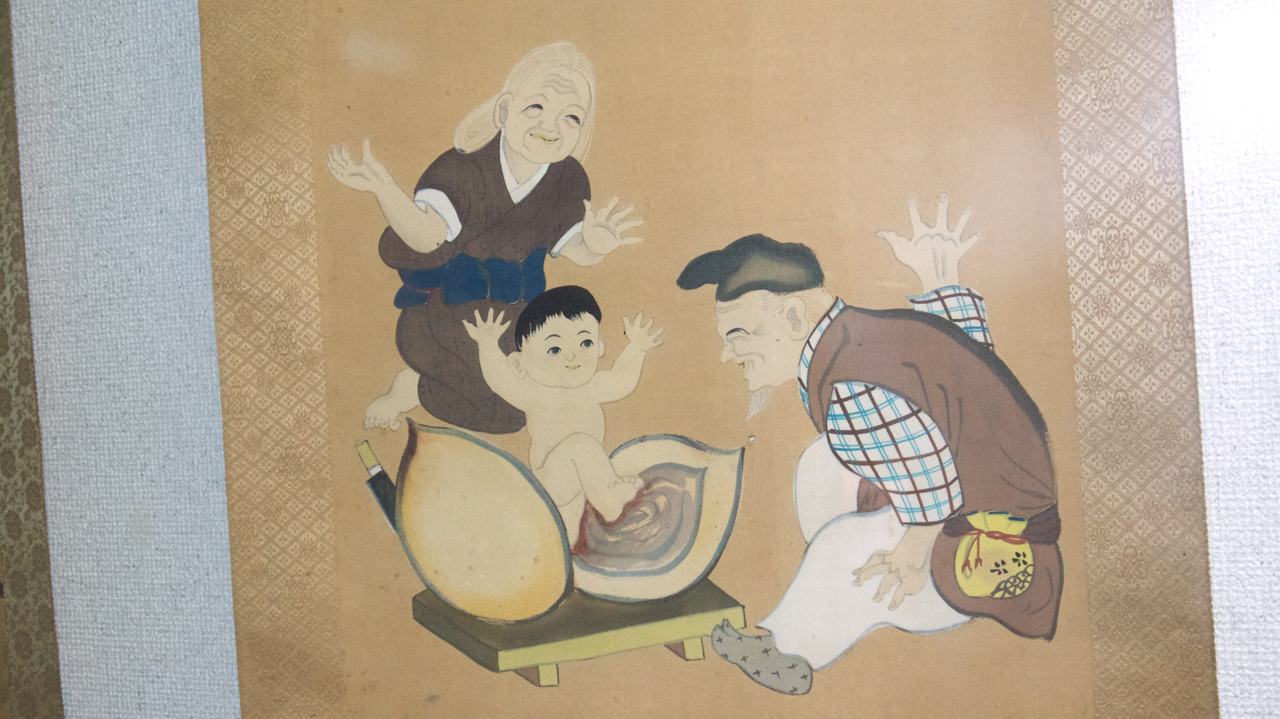
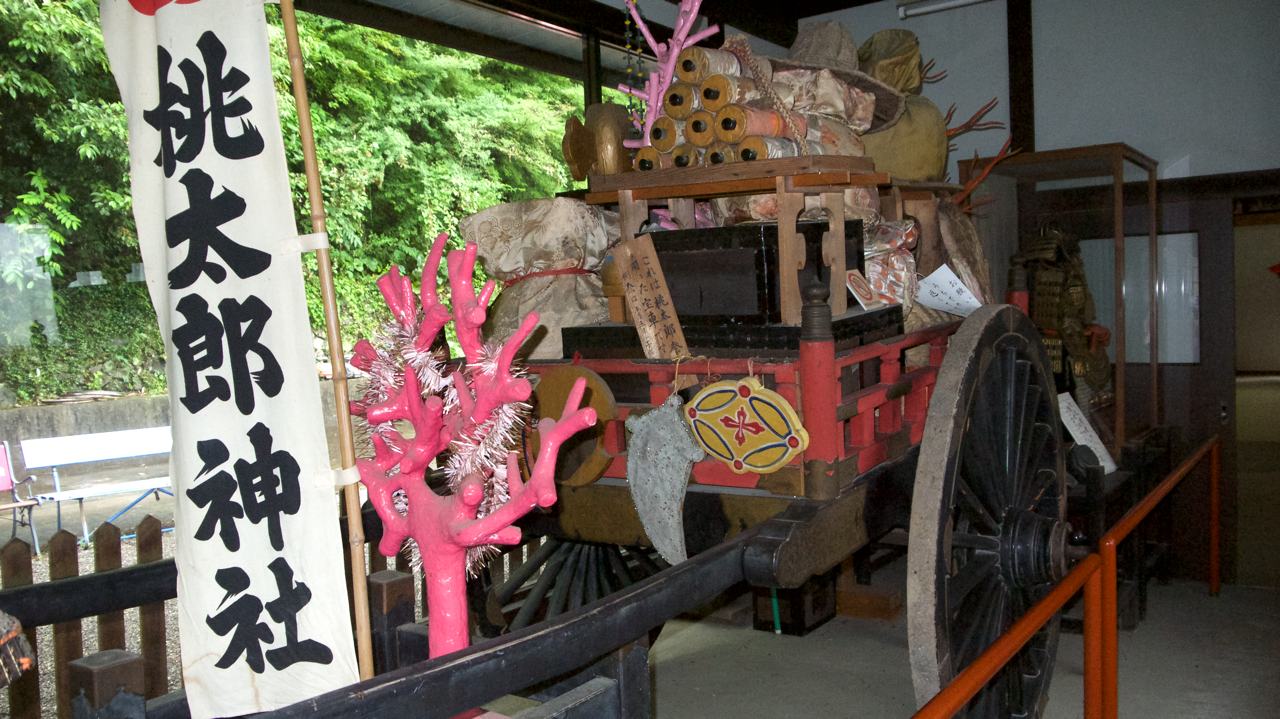
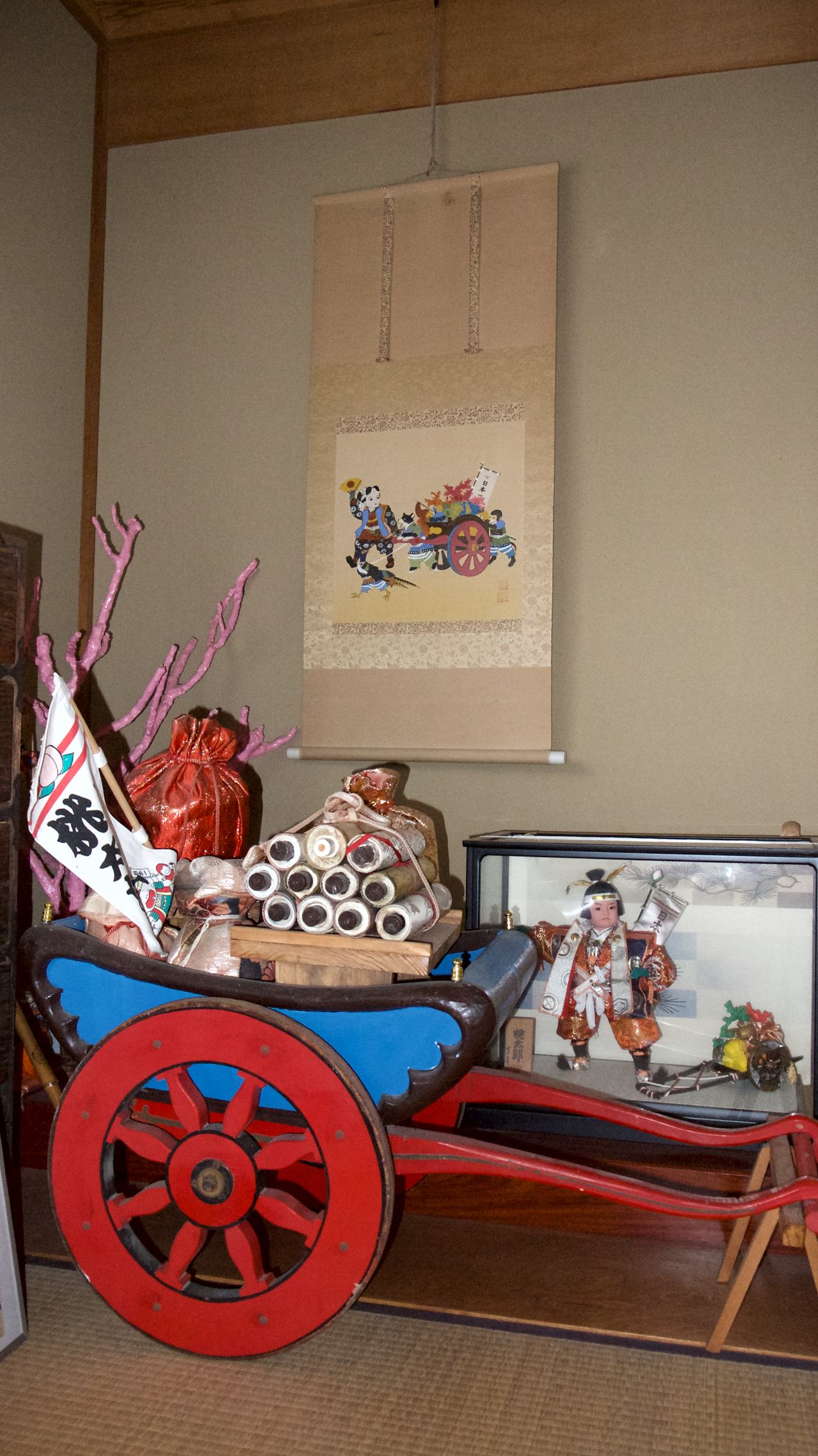
In the end, the shrine was a lot of fun and weirder than I expected. It's definitely the very best Momotarō shrine in the world, hands down.
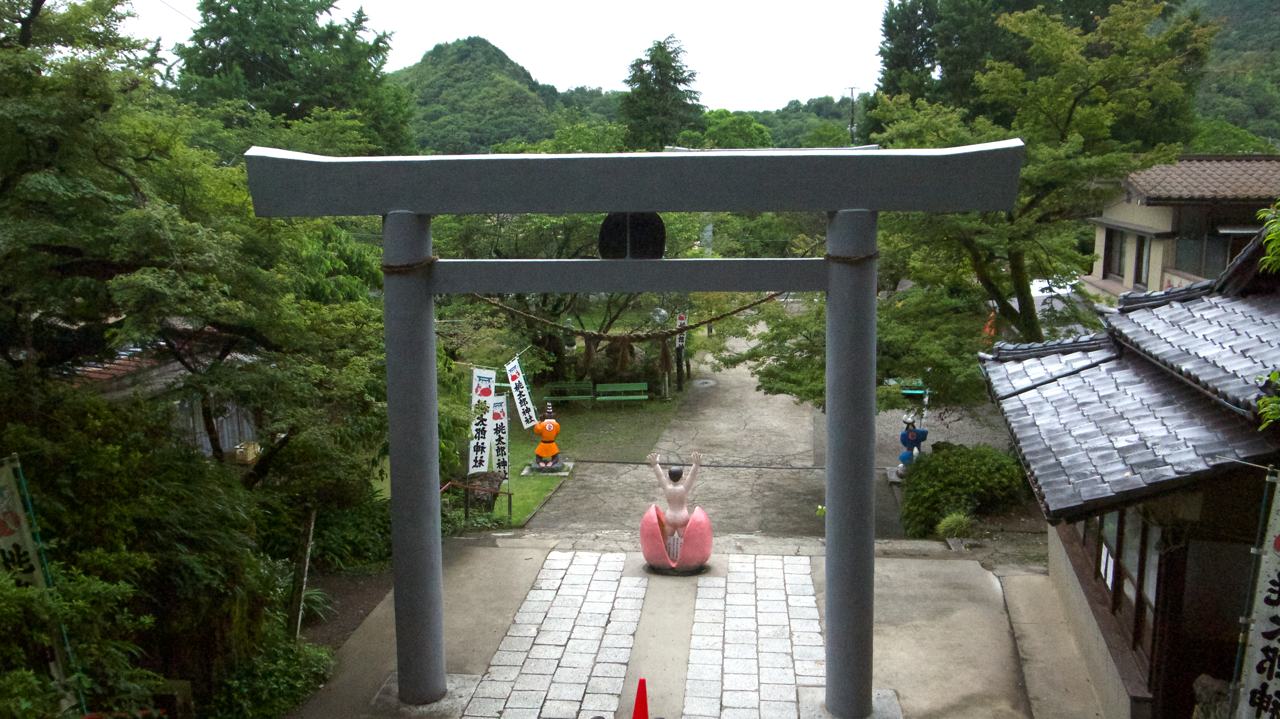
On the way back to the entrance, I noticed a sign right beneath baby Momotarō's butt that reads, "It's dangerous, so don't ride on Momotarō."
Why put that right beneath his butt? Did someone try this already?
It was the weird icing on this weird cake. If you're still not sure if you'll enjoy this shrine, you know now.

Overall, I had a blast, even though it took a long time to get to the shrine and not very long to go through.
Considering all the sculptures were made in the 50s and 60s, I imagine this place was a bigger deal in the Shōwa period when there were no video games, smartphones, or Internetz. Kids these days can't appreciate Japanese folklore statues…
This shrine may be a novelty today, but I imagine a lot of kids loved coming here and seeing Asano's colorfully bizarre statues, riding the abandoned scooters, and sitting on the back of やさしい鬼.
Today, the shrine remains an important place for the people of Inuyama to pray for their children's health. And on May the 5th, Children's Day in Japan, the shrine hosts a Momotarō Festival. The pictures online look really cute, so now that I have a baby girl, I know I'll be back at this shrine again someday before she's too old to dress up as Momotarō.
Mami’s Review
It was a unique shrine, but that was it. Unless it’s spring or fall, when cherry blossoms are in bloom or leaves change color, I wouldn’t go back. Maybe even around that time, I wouldn’t go back unless I have something else to do around that place.
Momotarō Shrine
Additional Information
Ohira-853 Kurisu
Inuyama, Aichi 484-0002
Japan
81 568-61-1586
